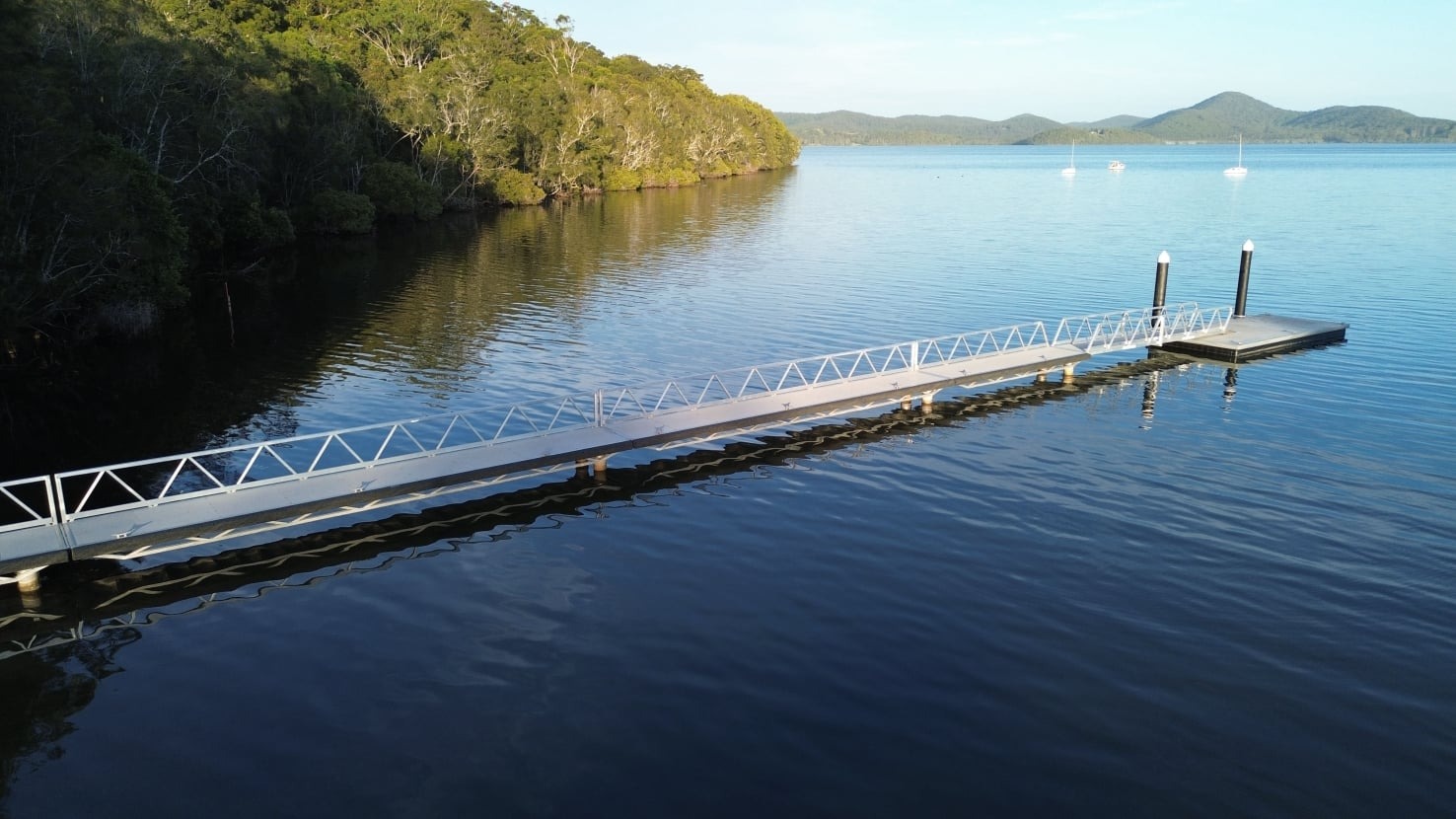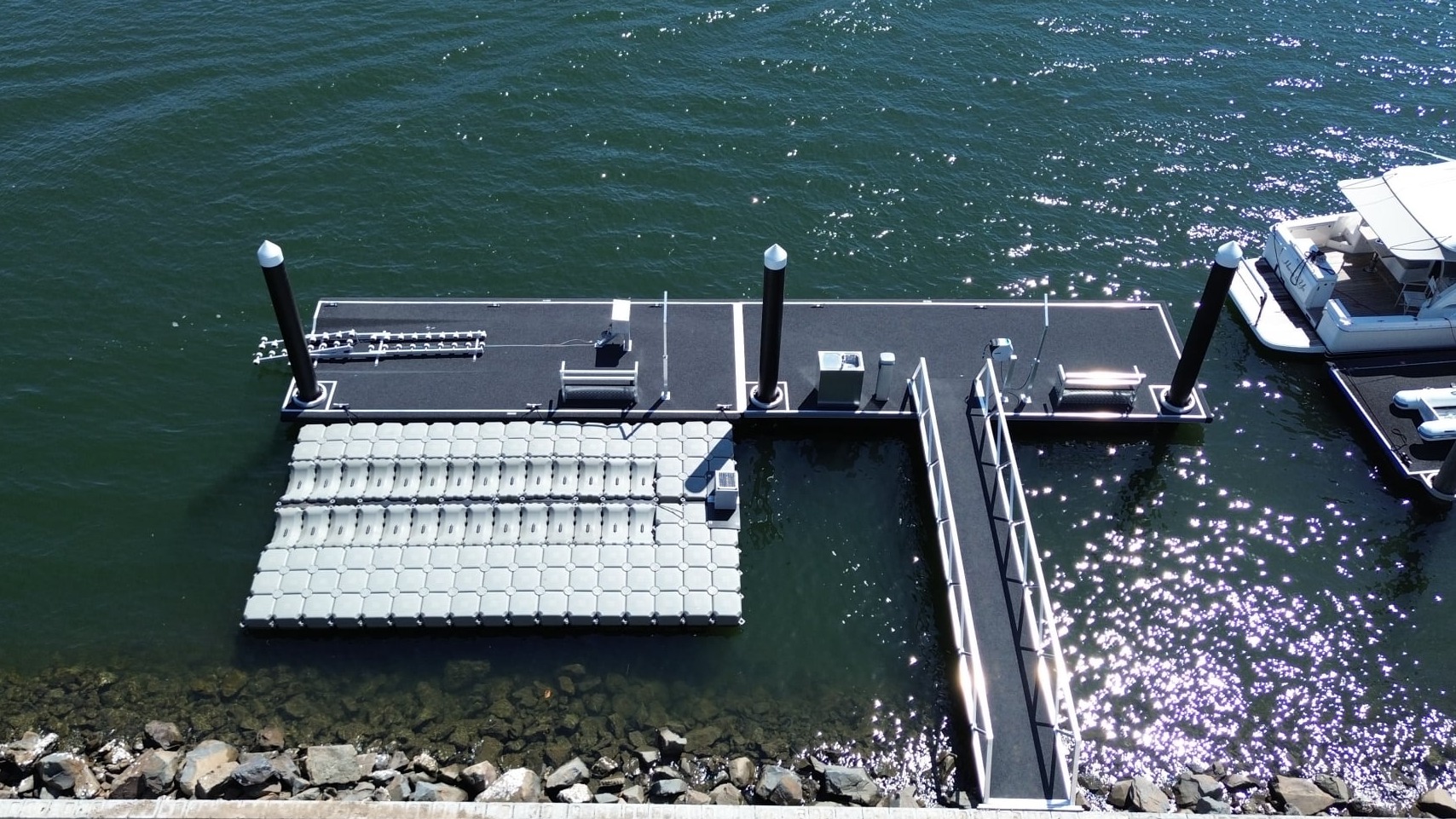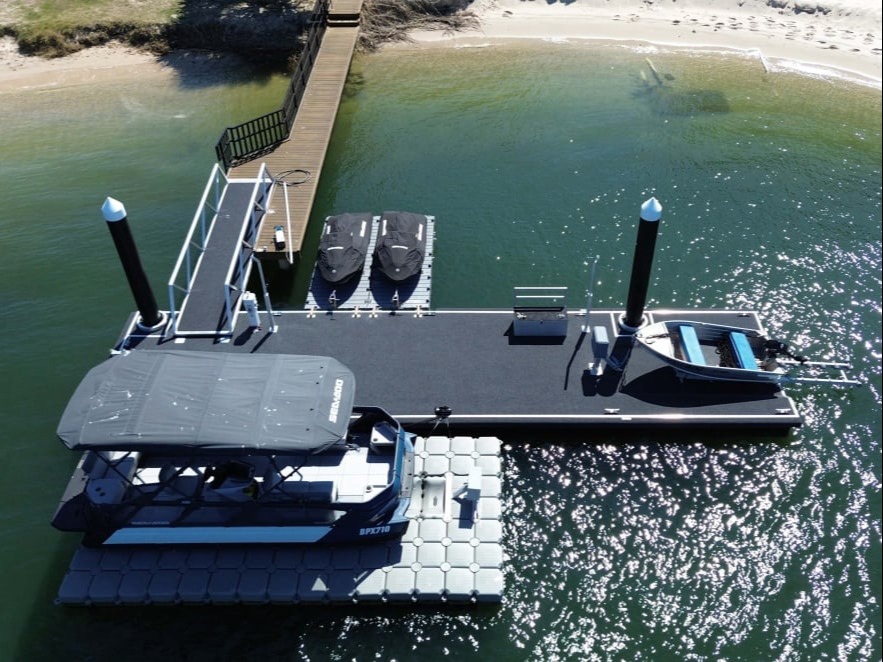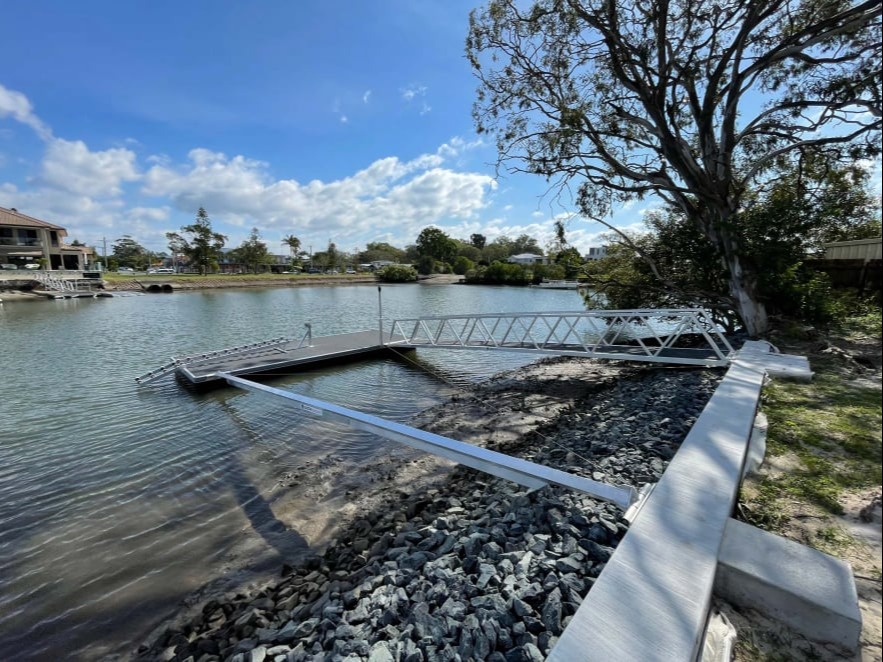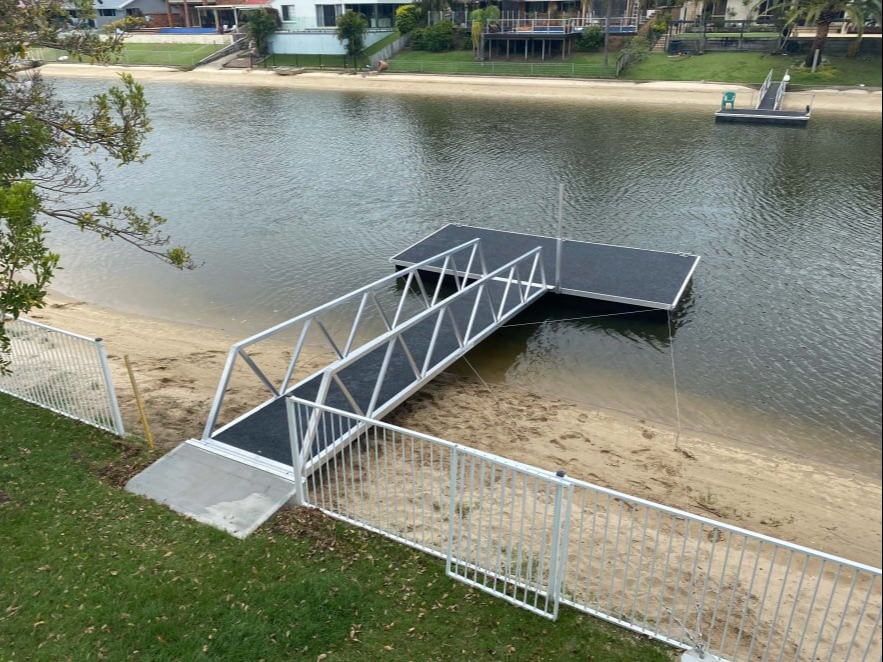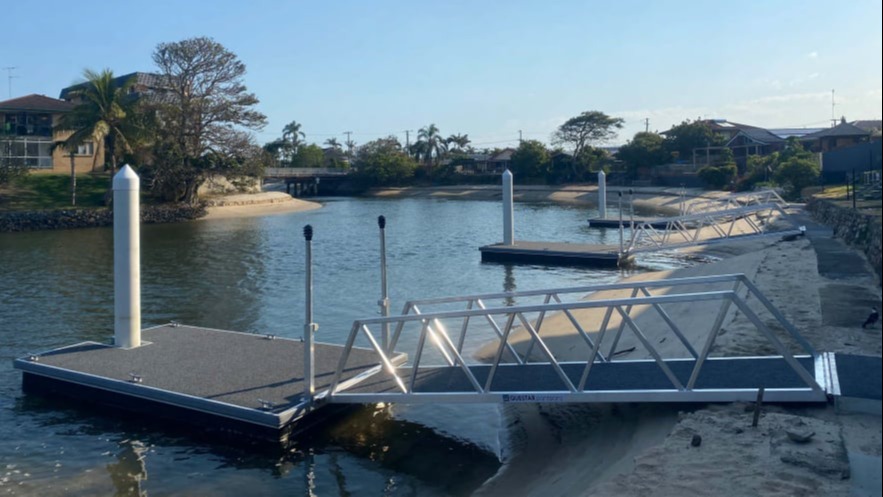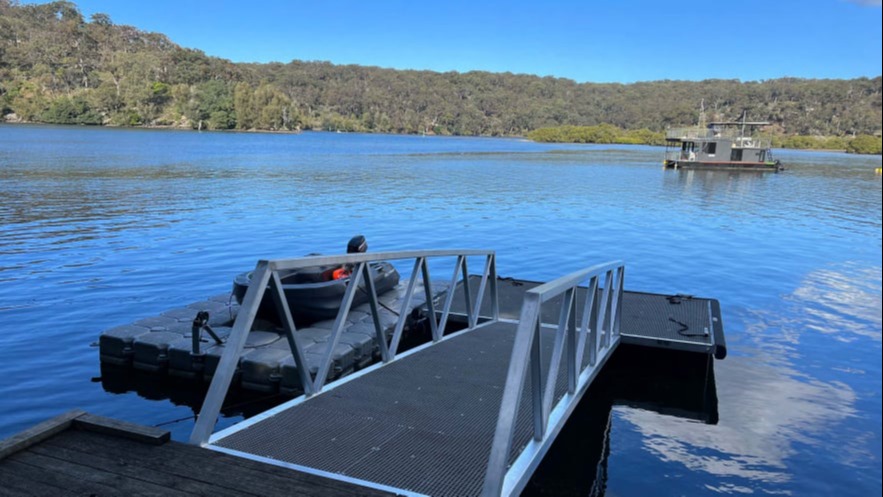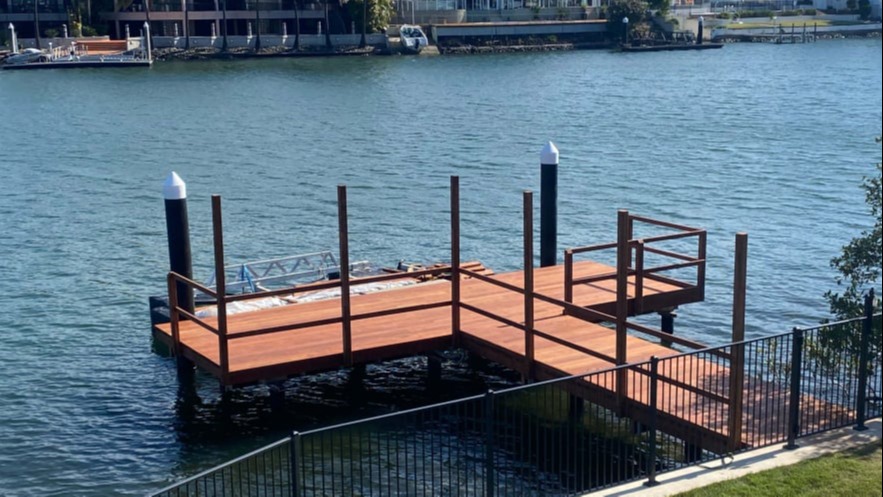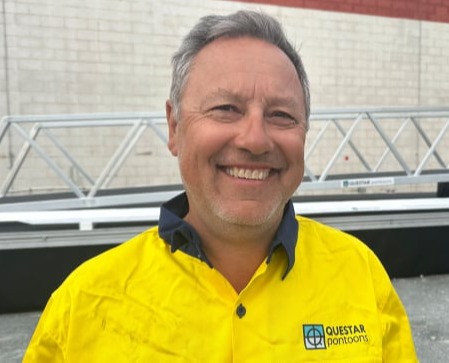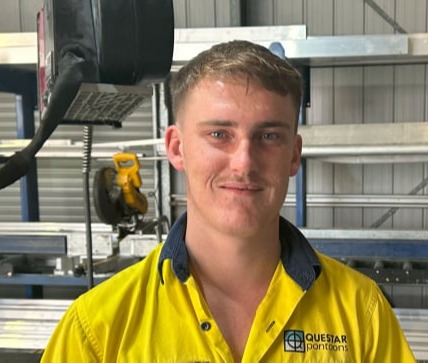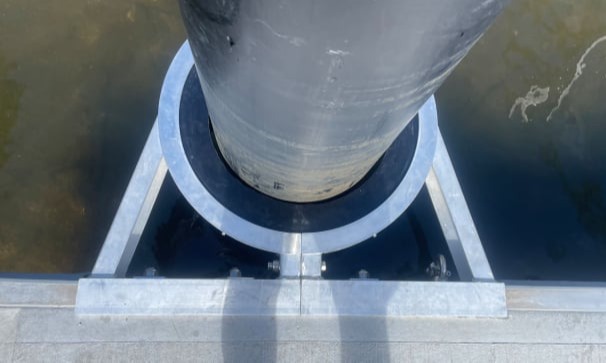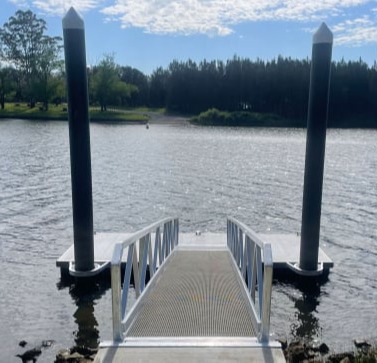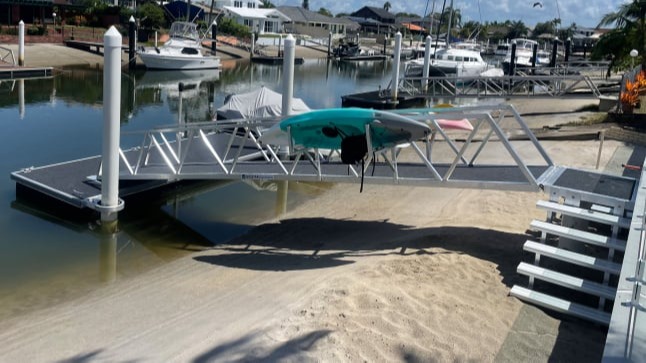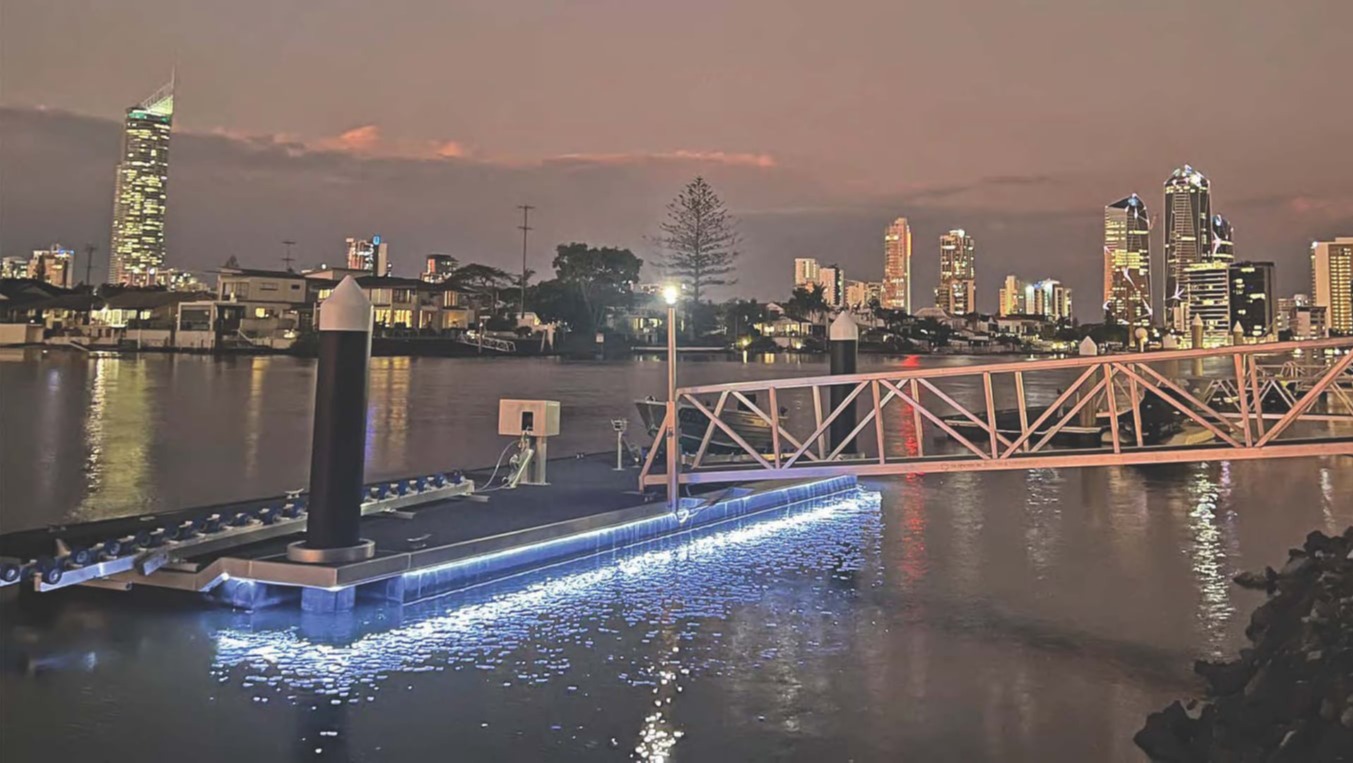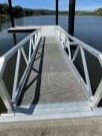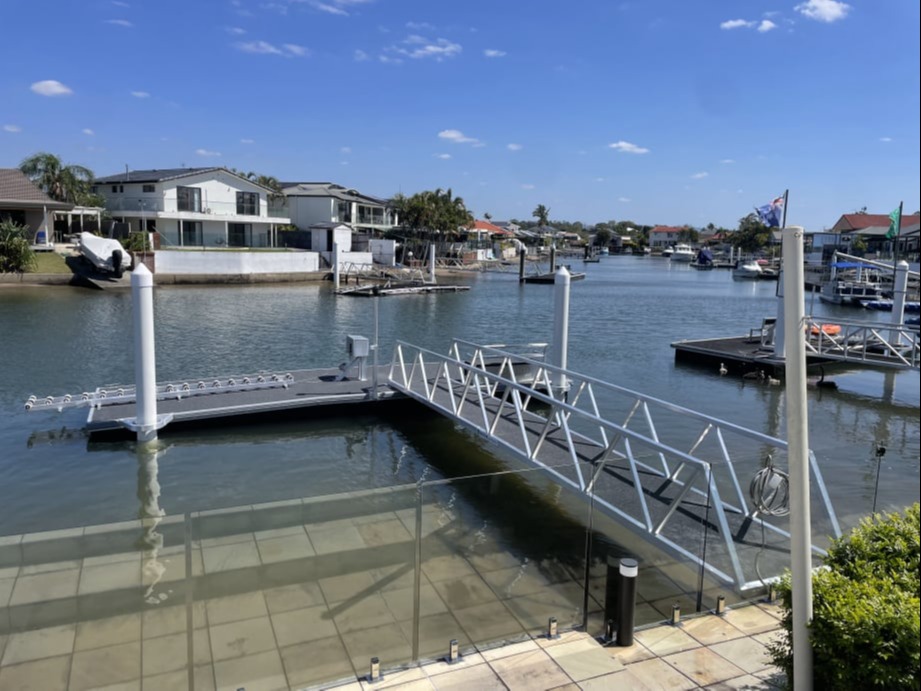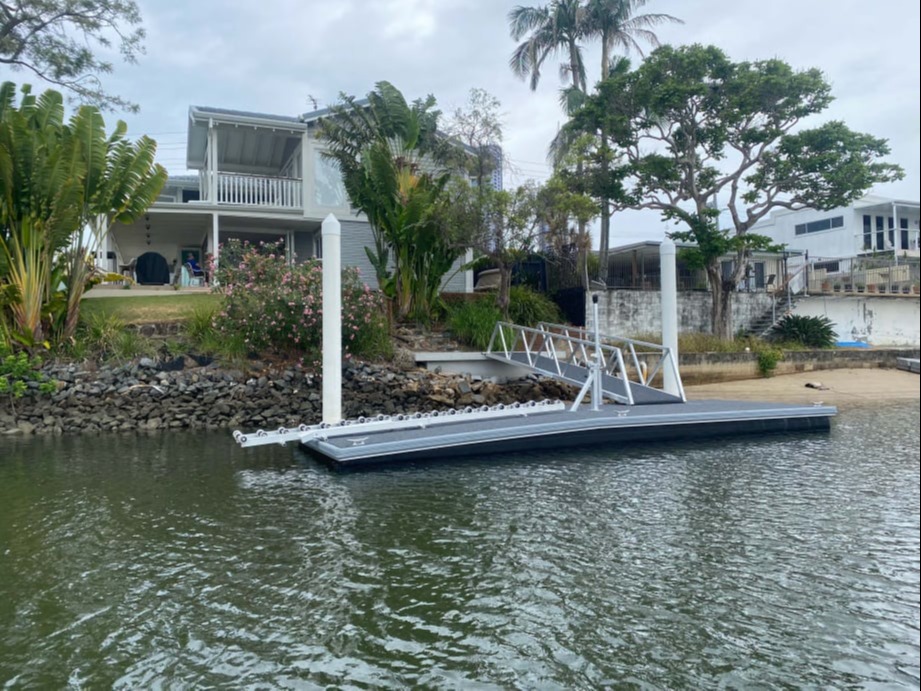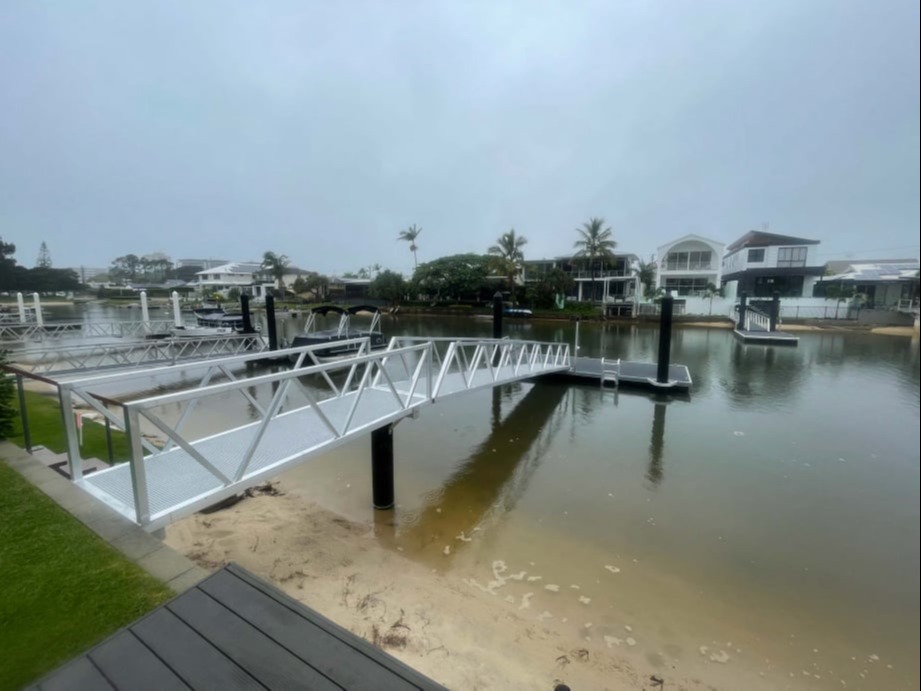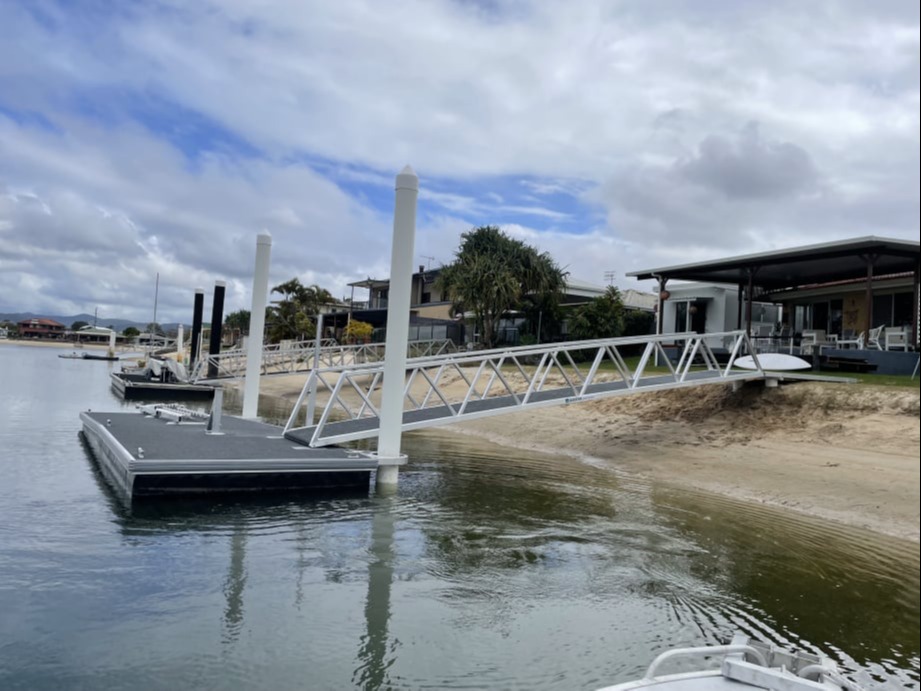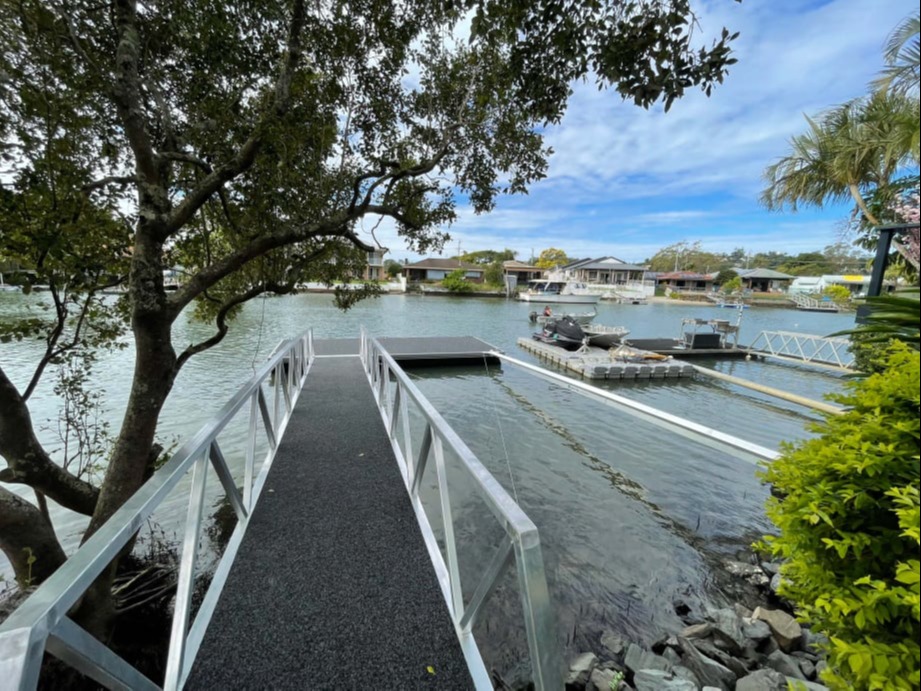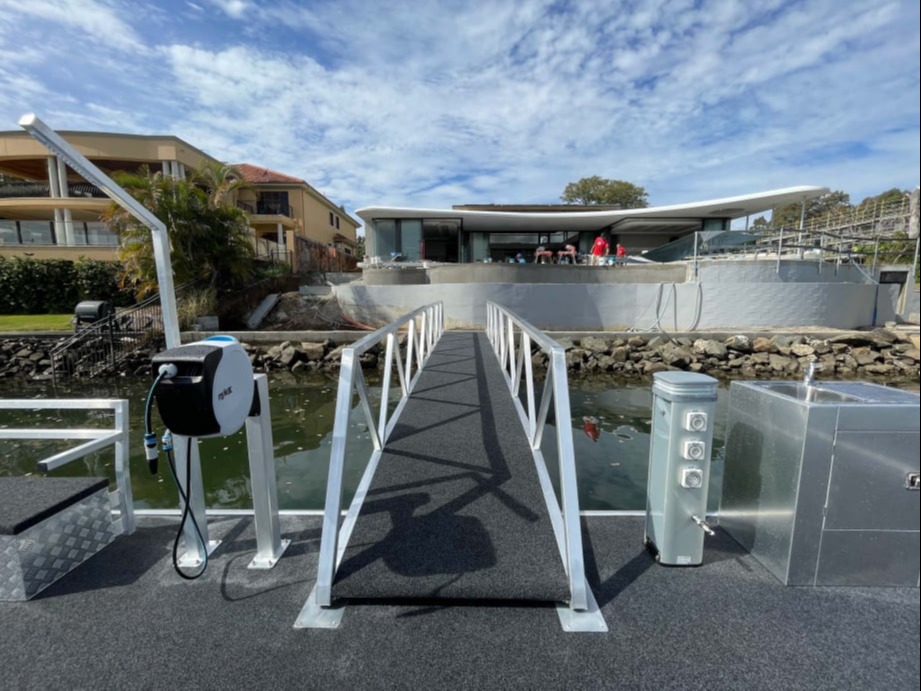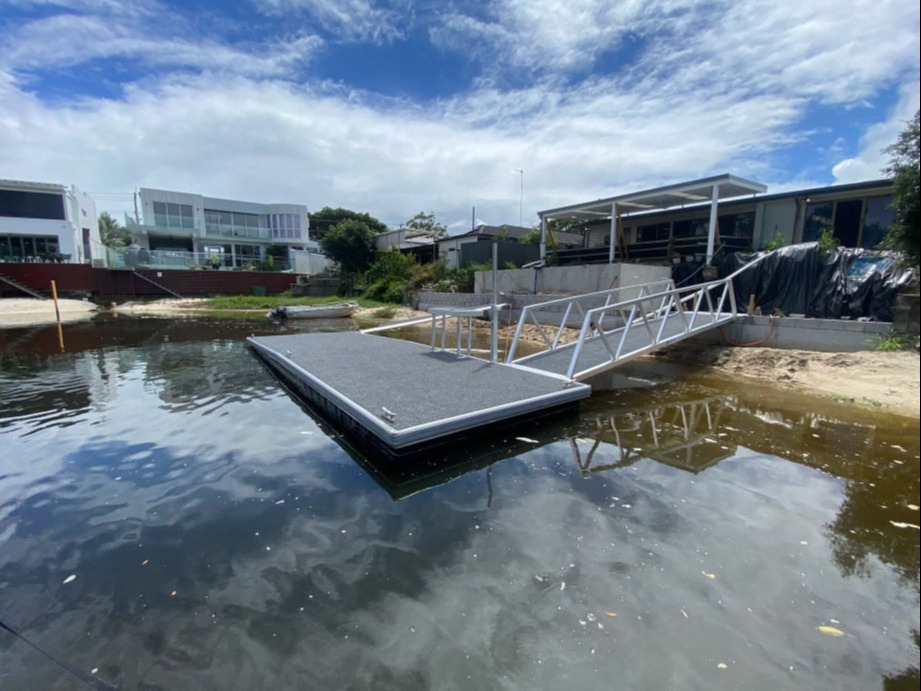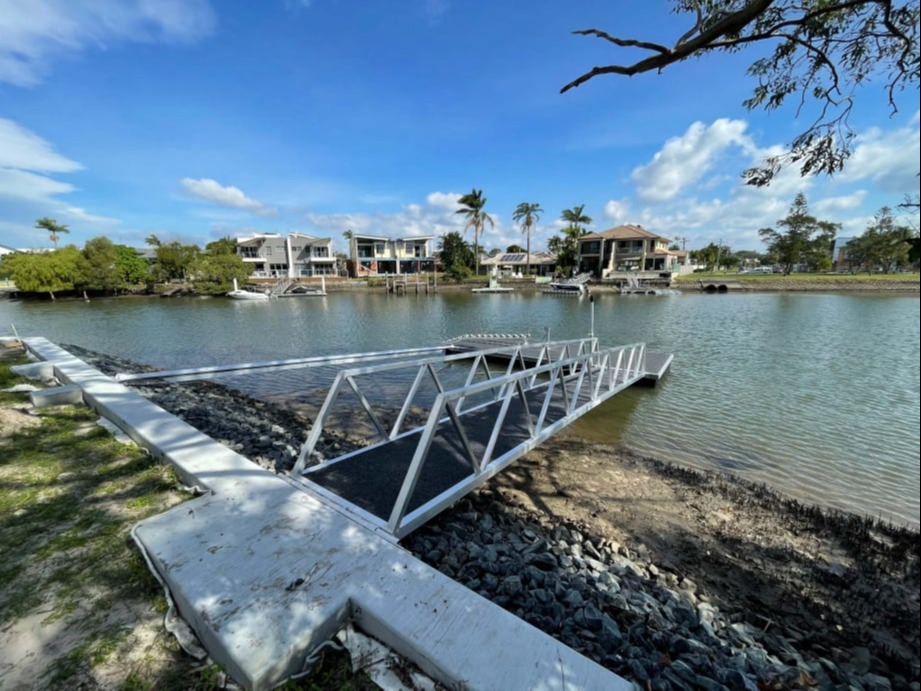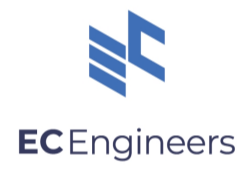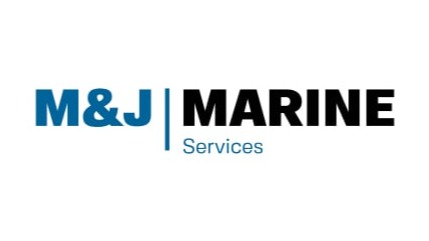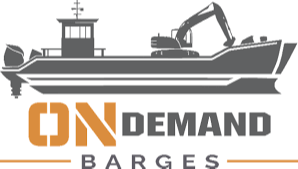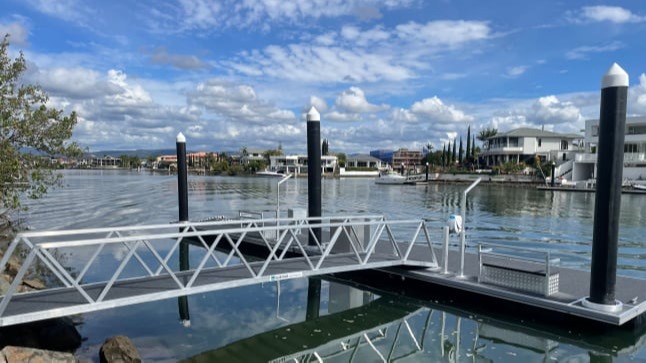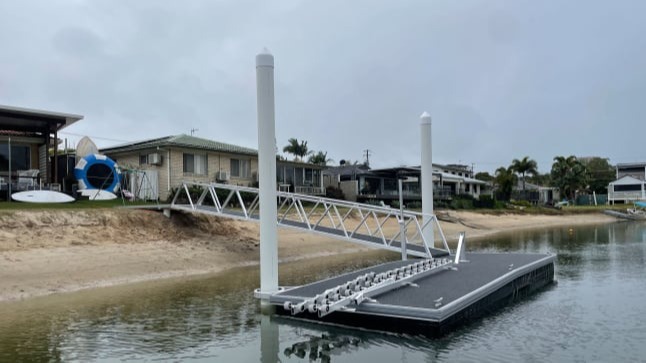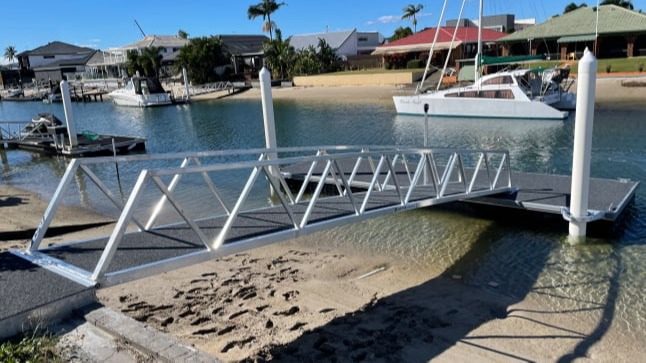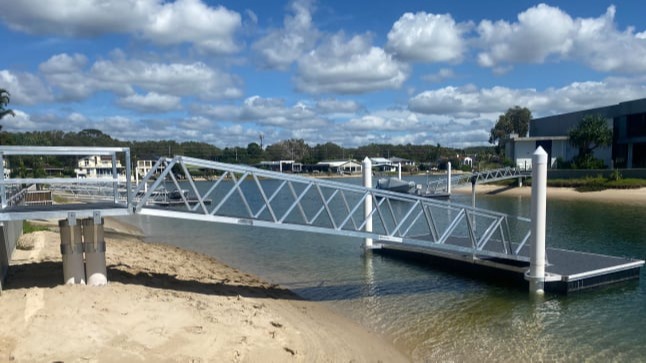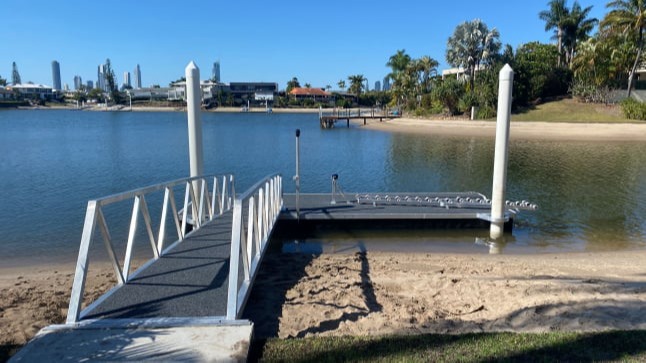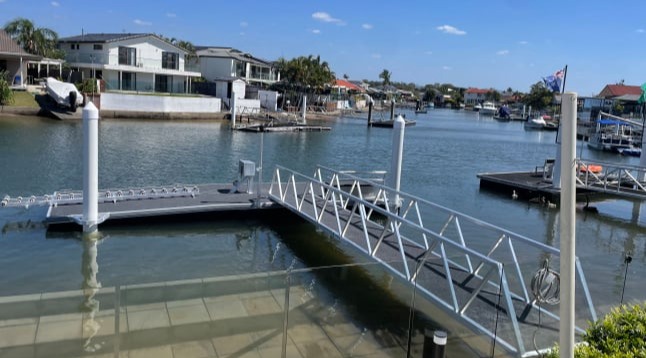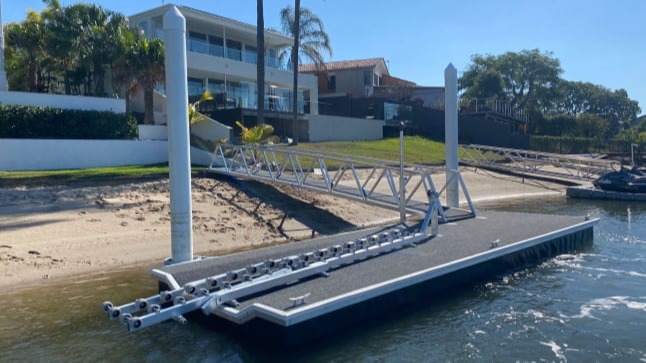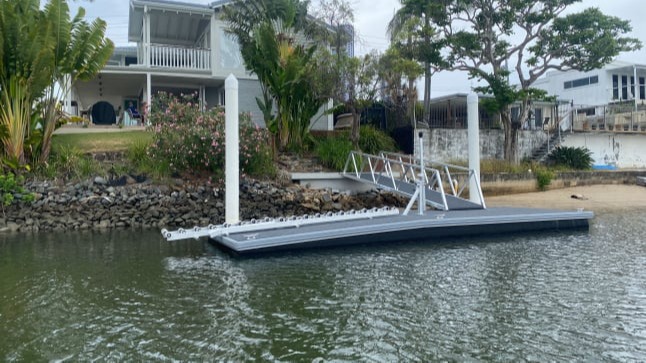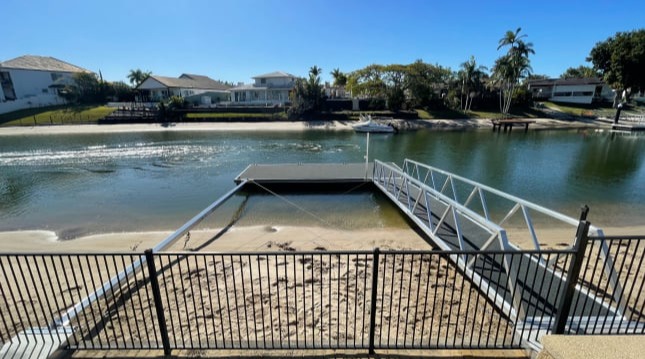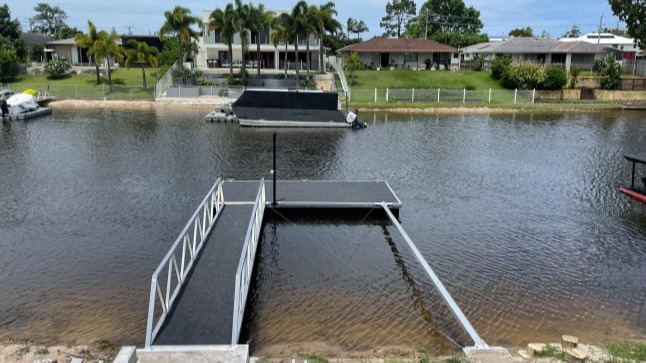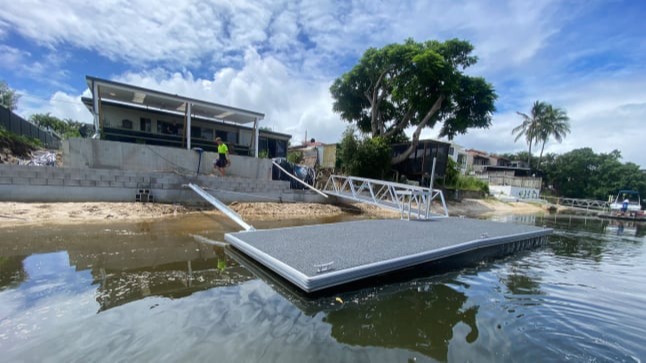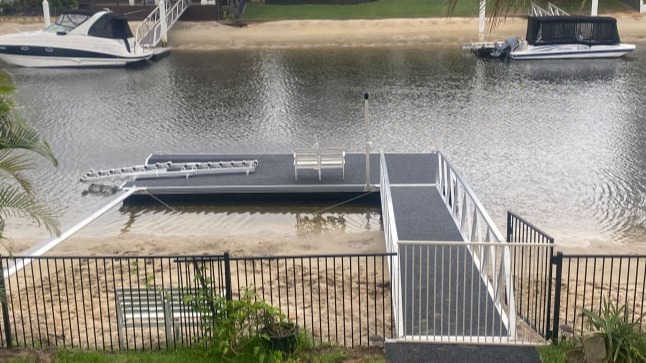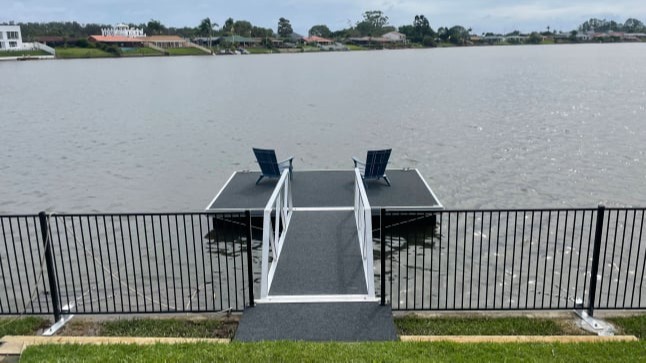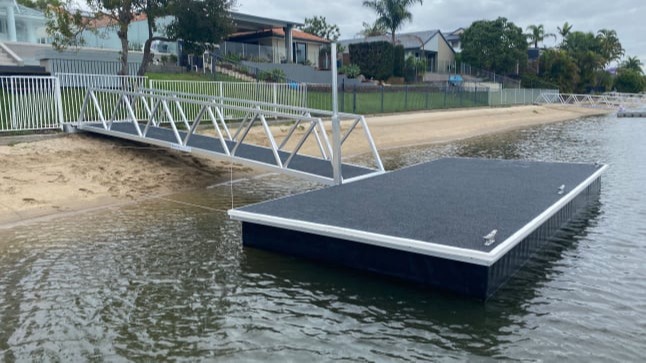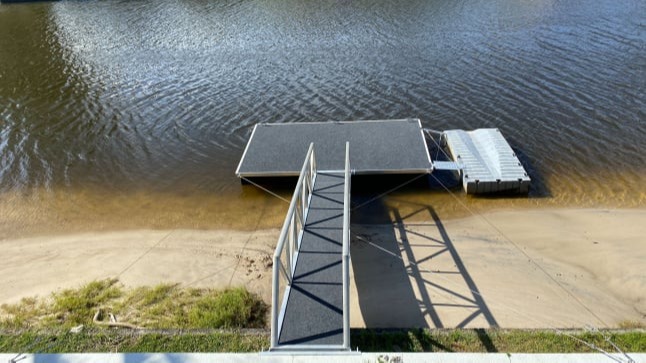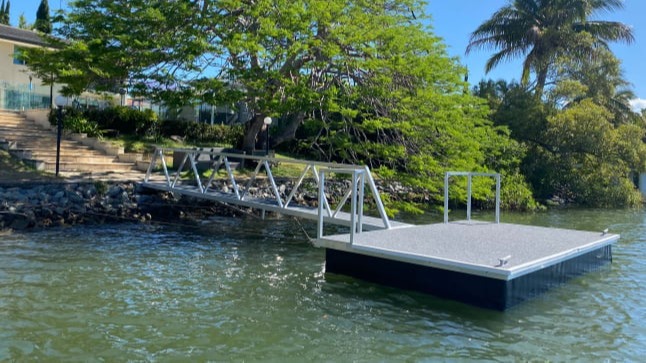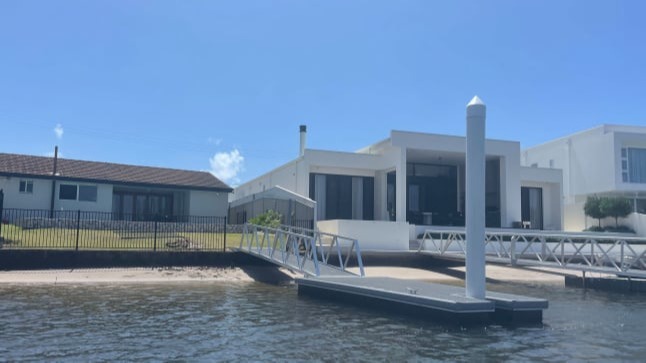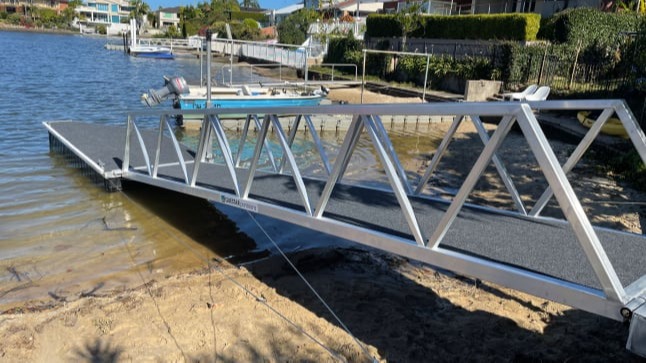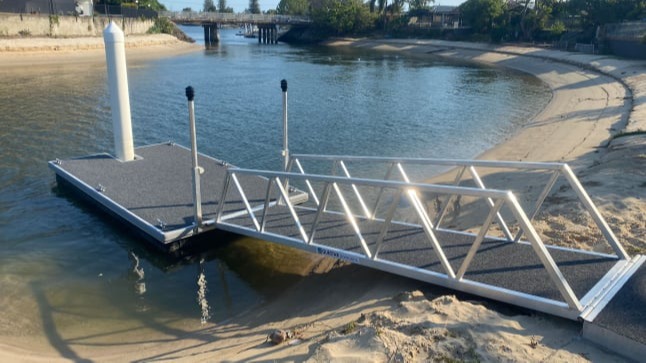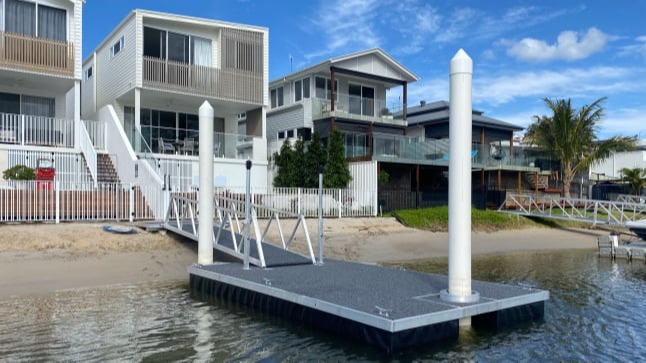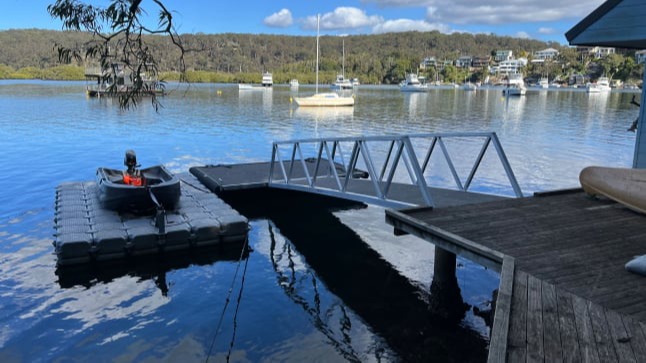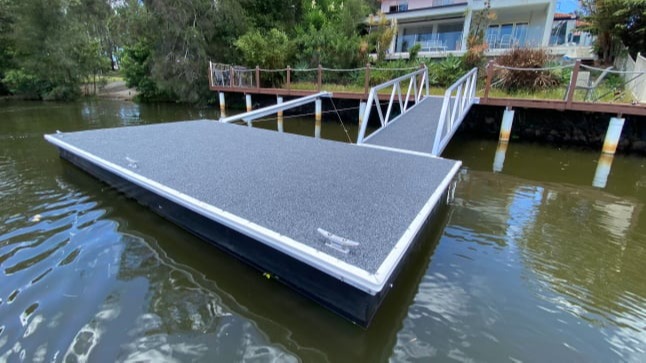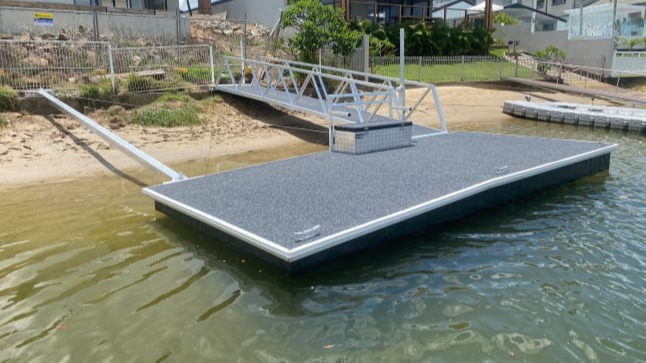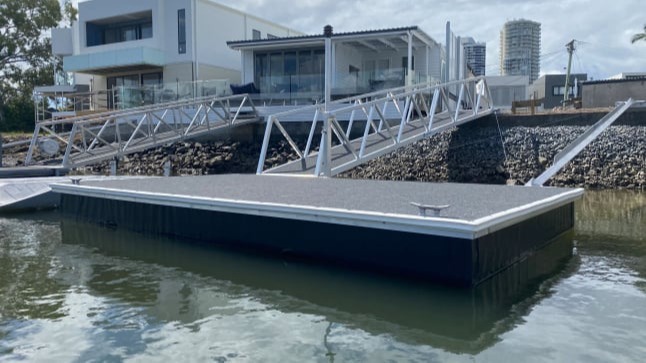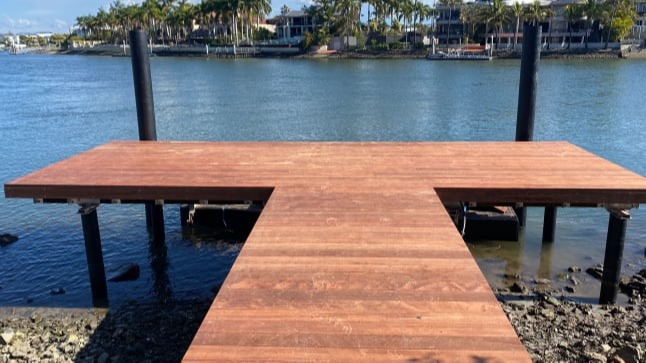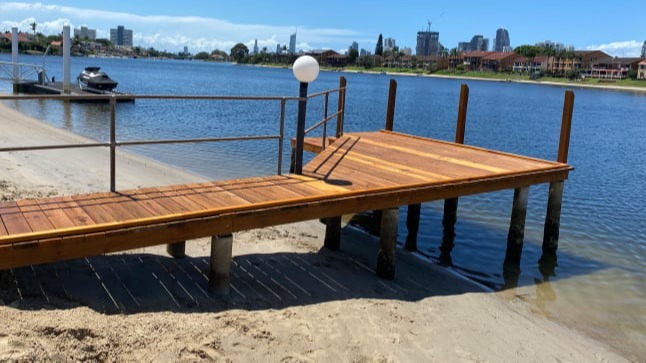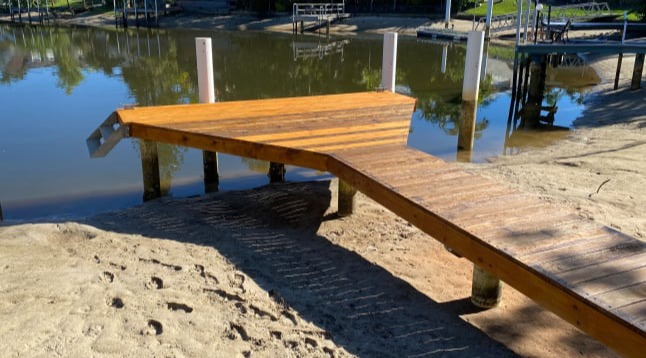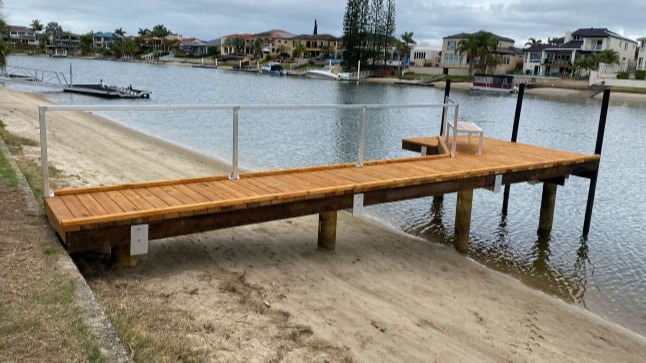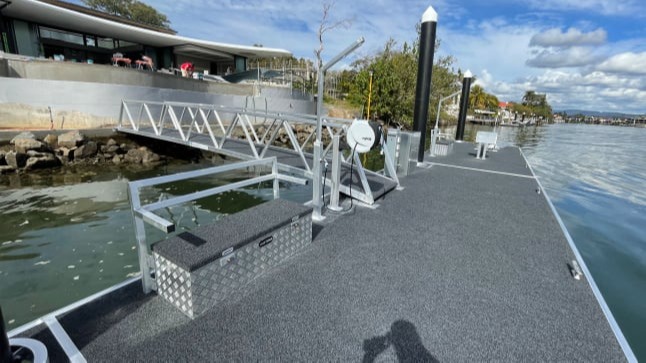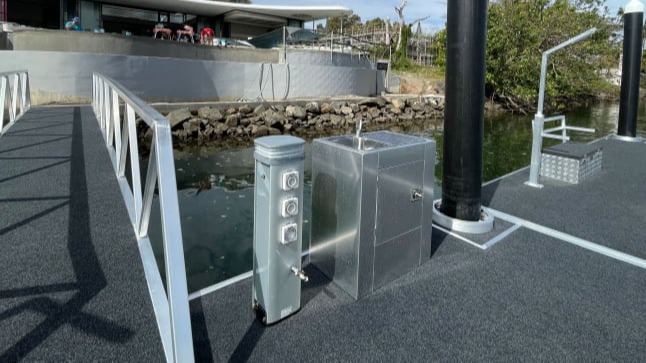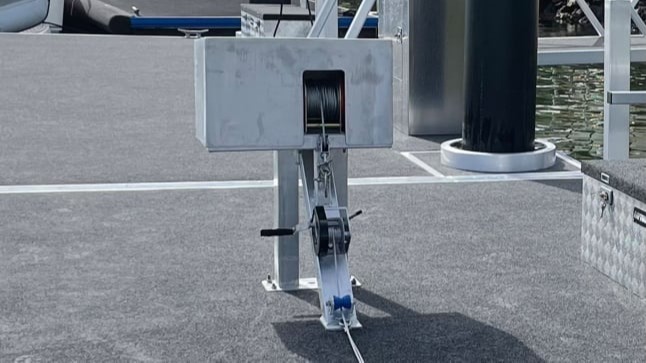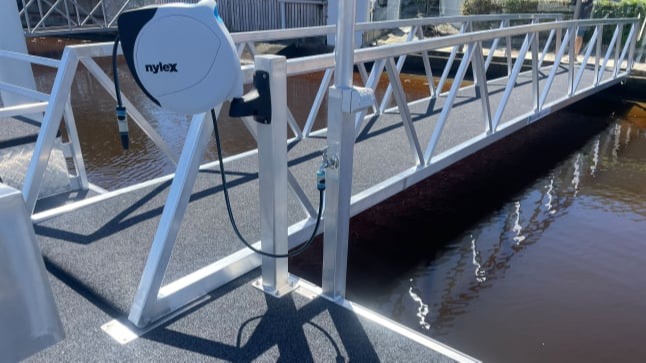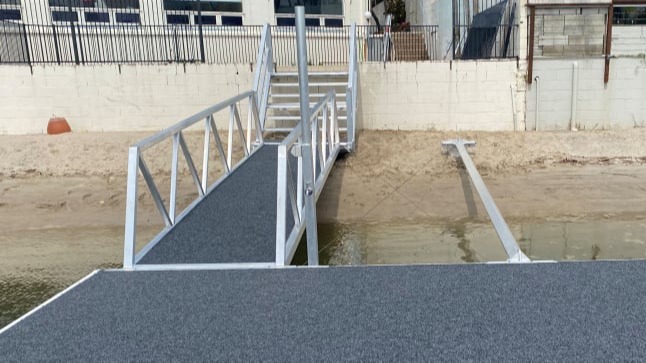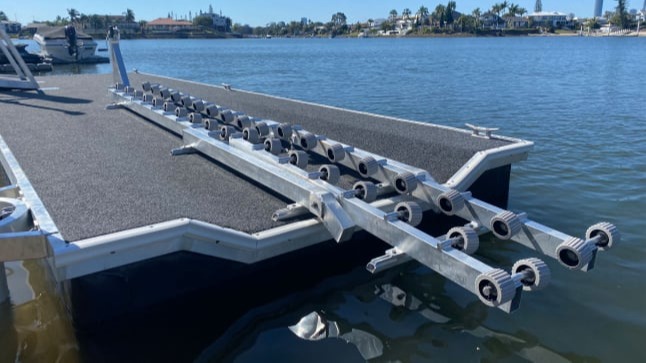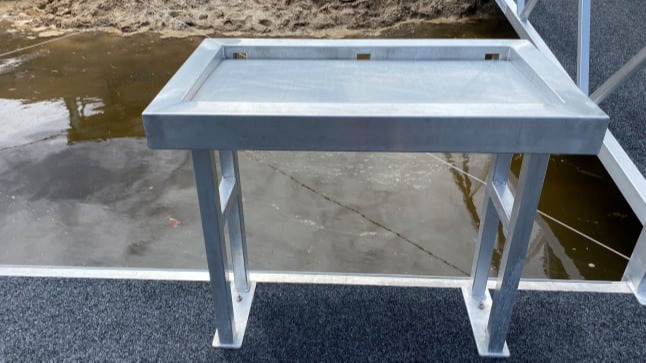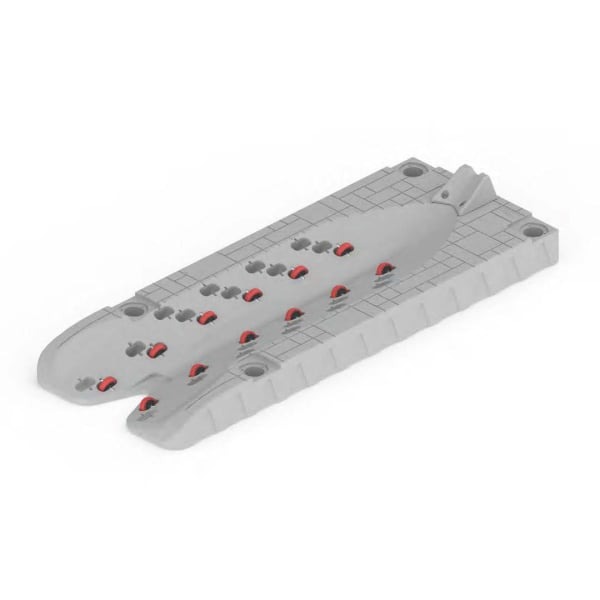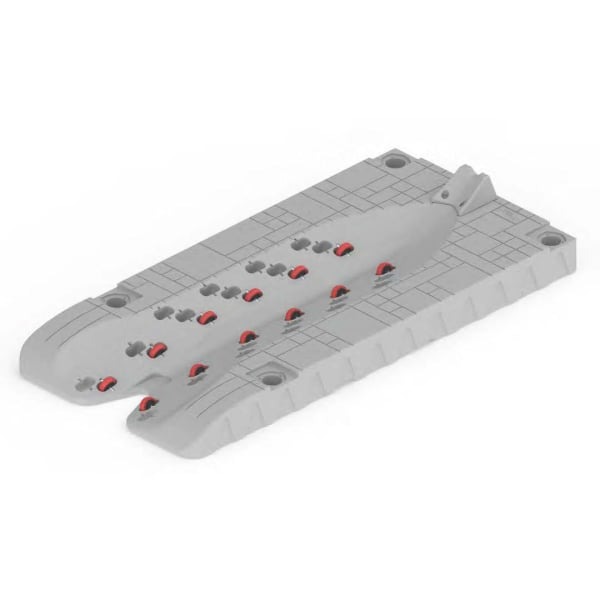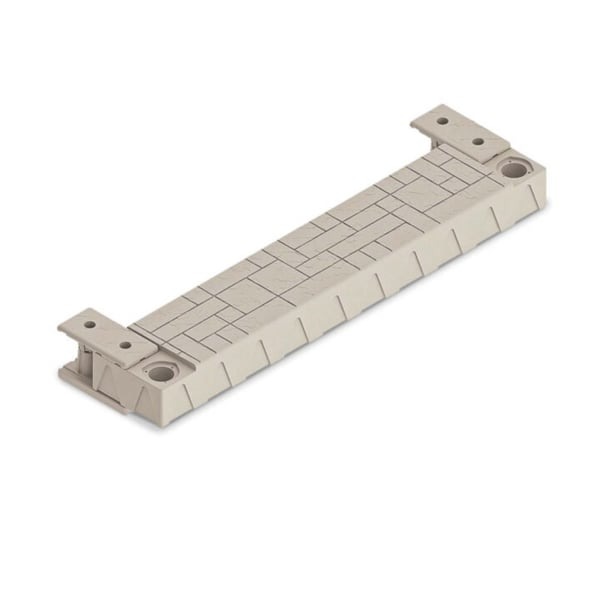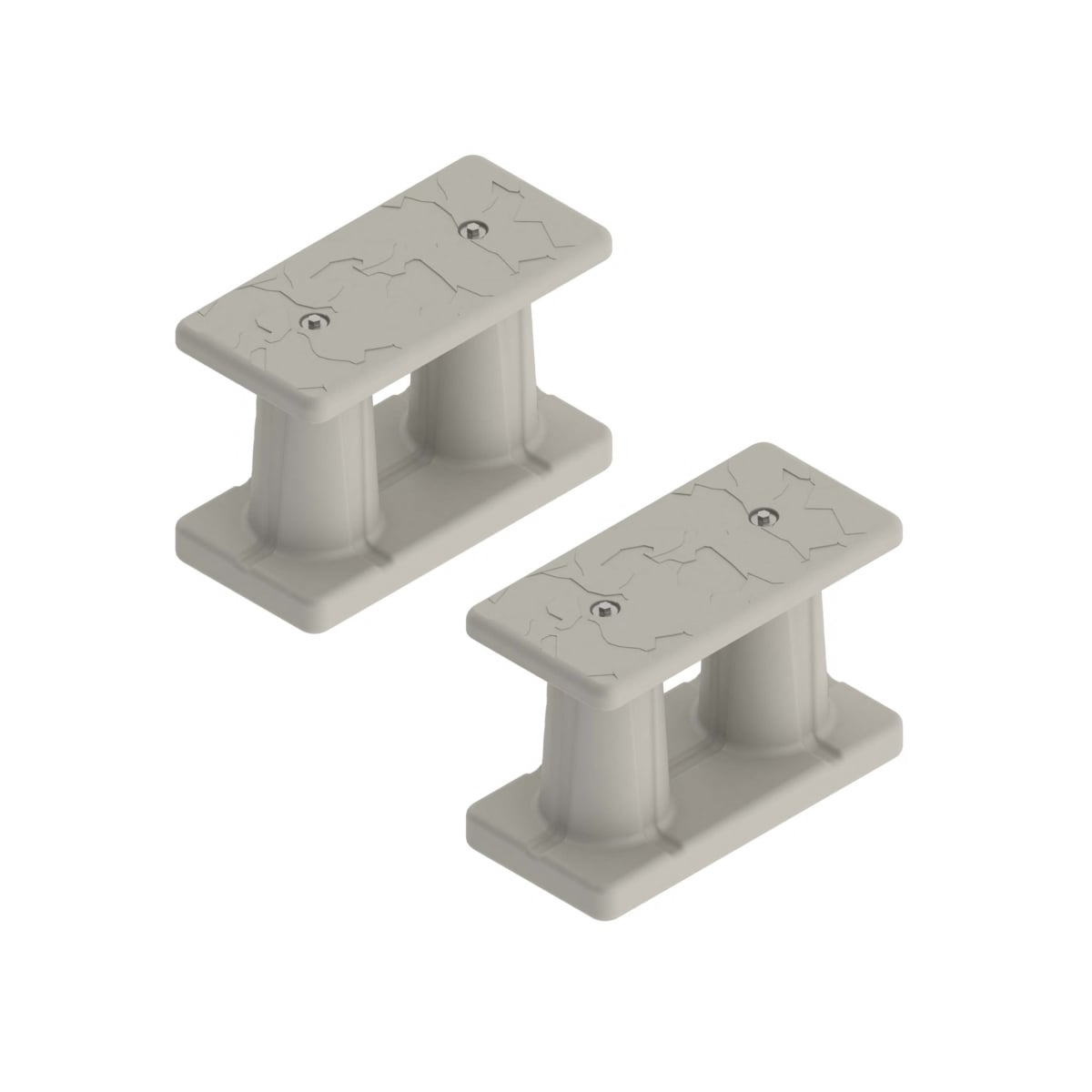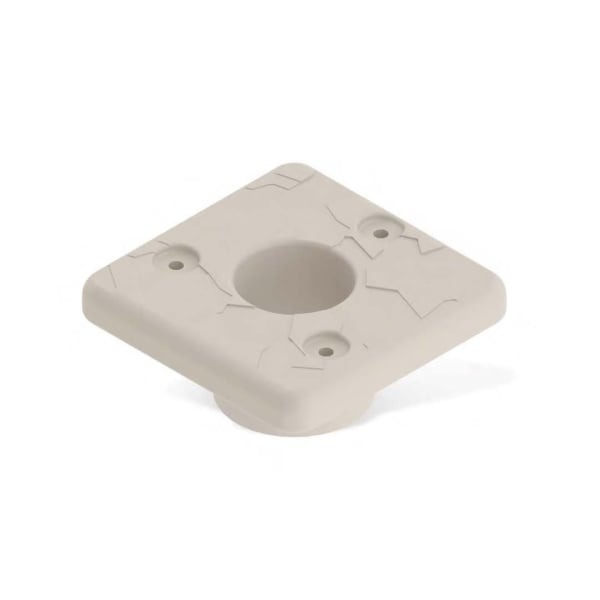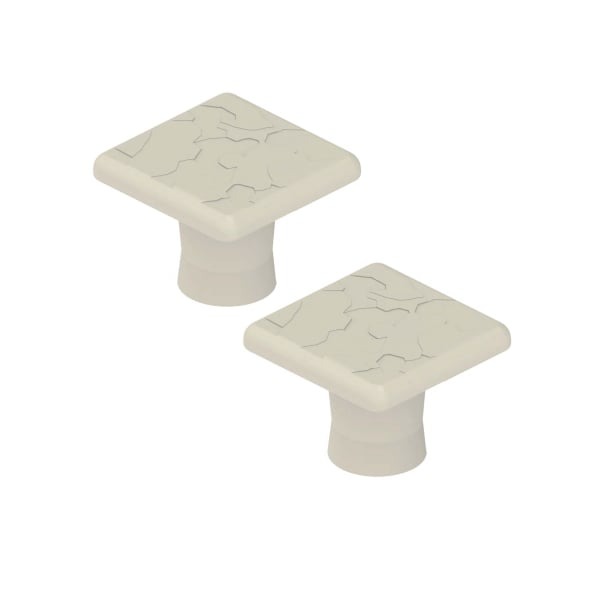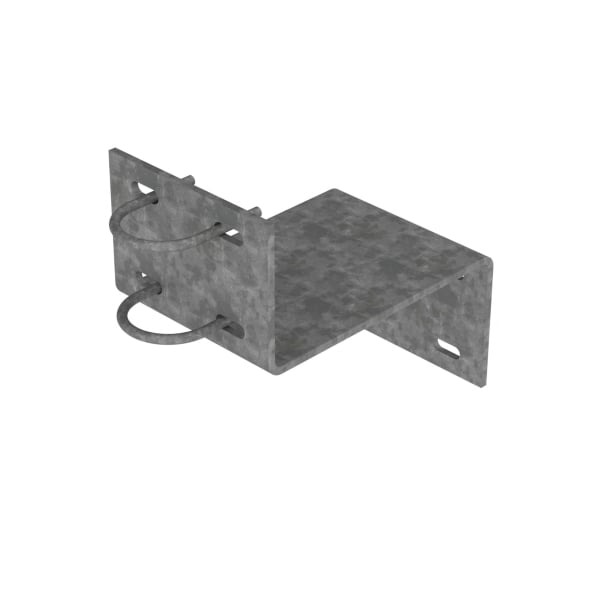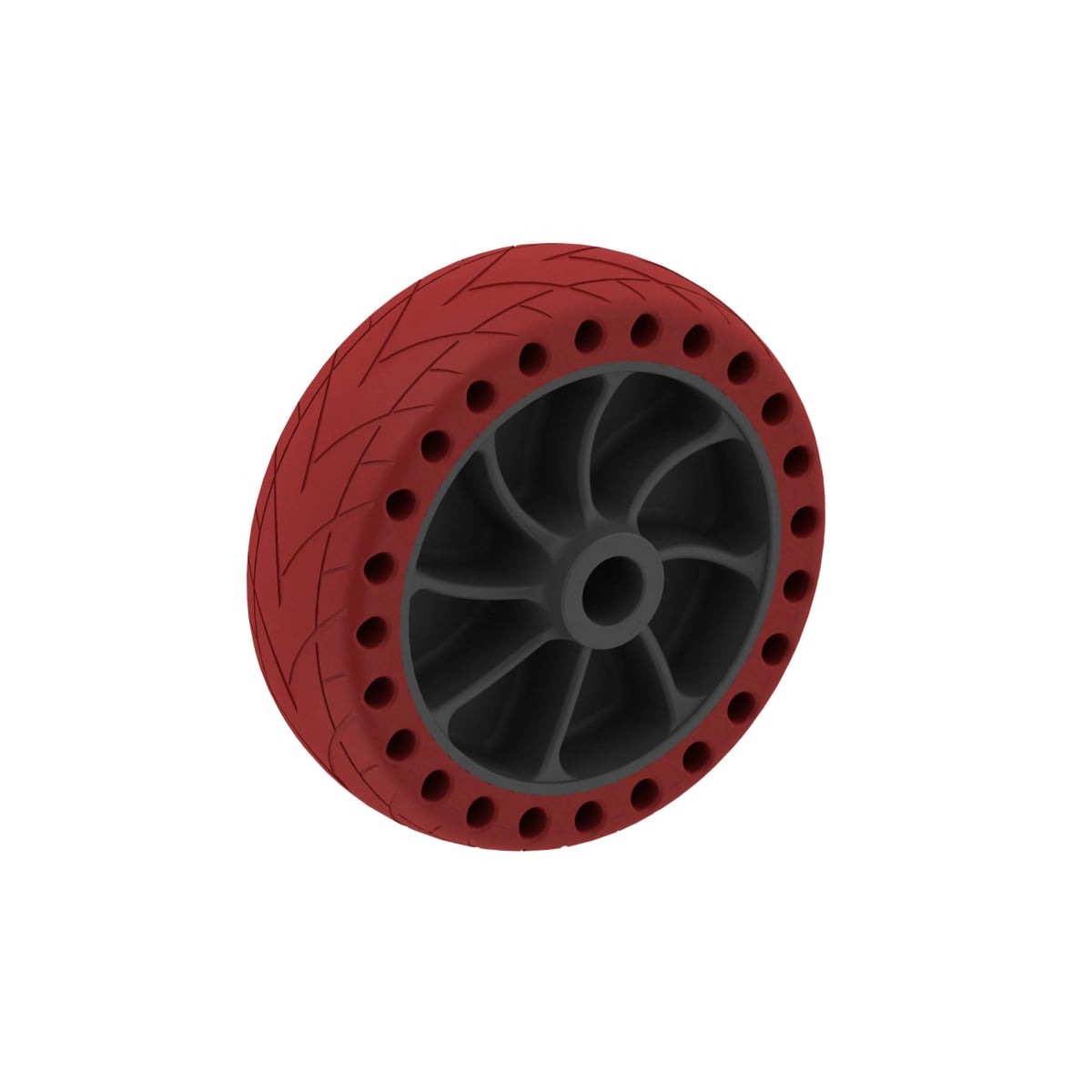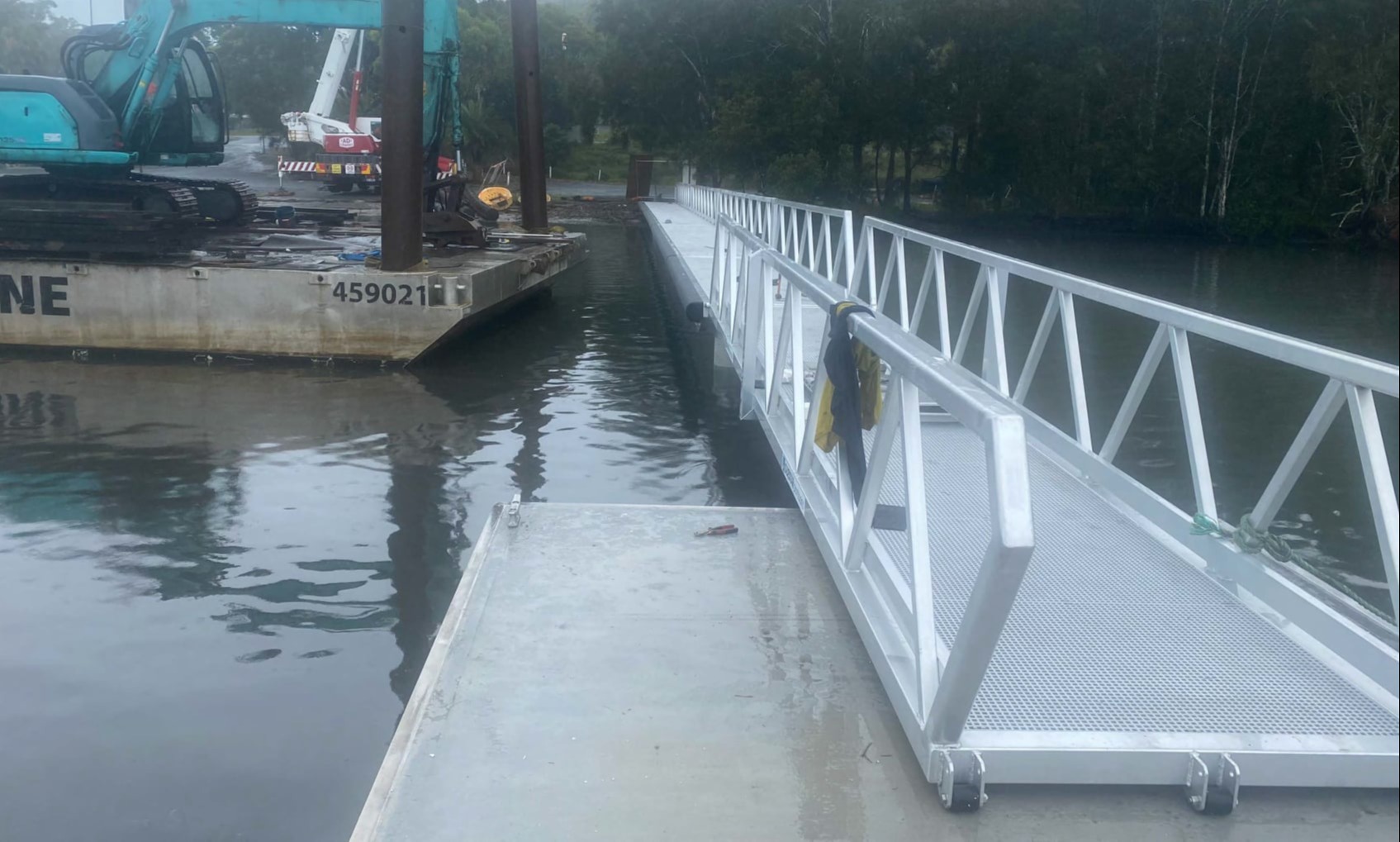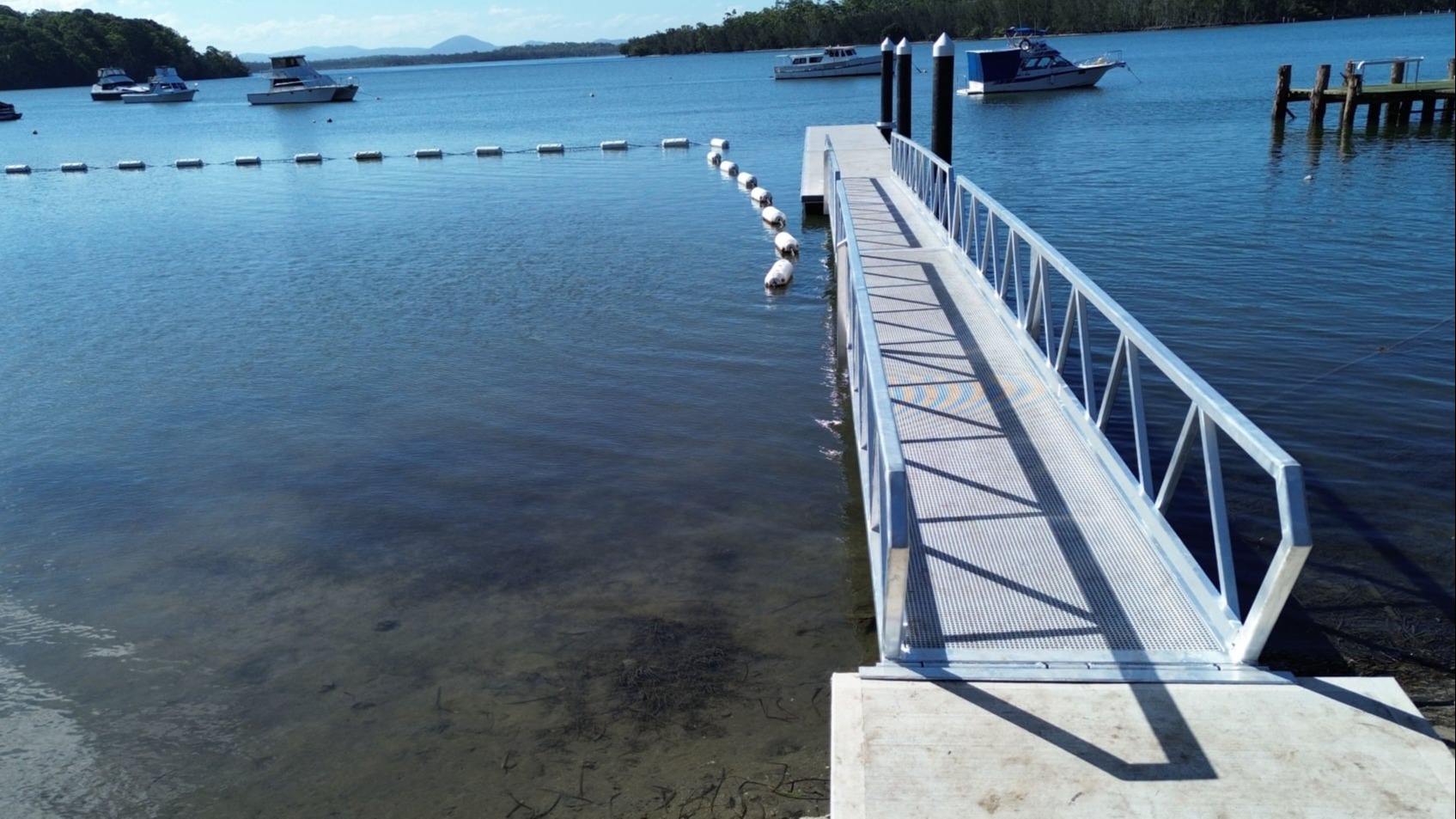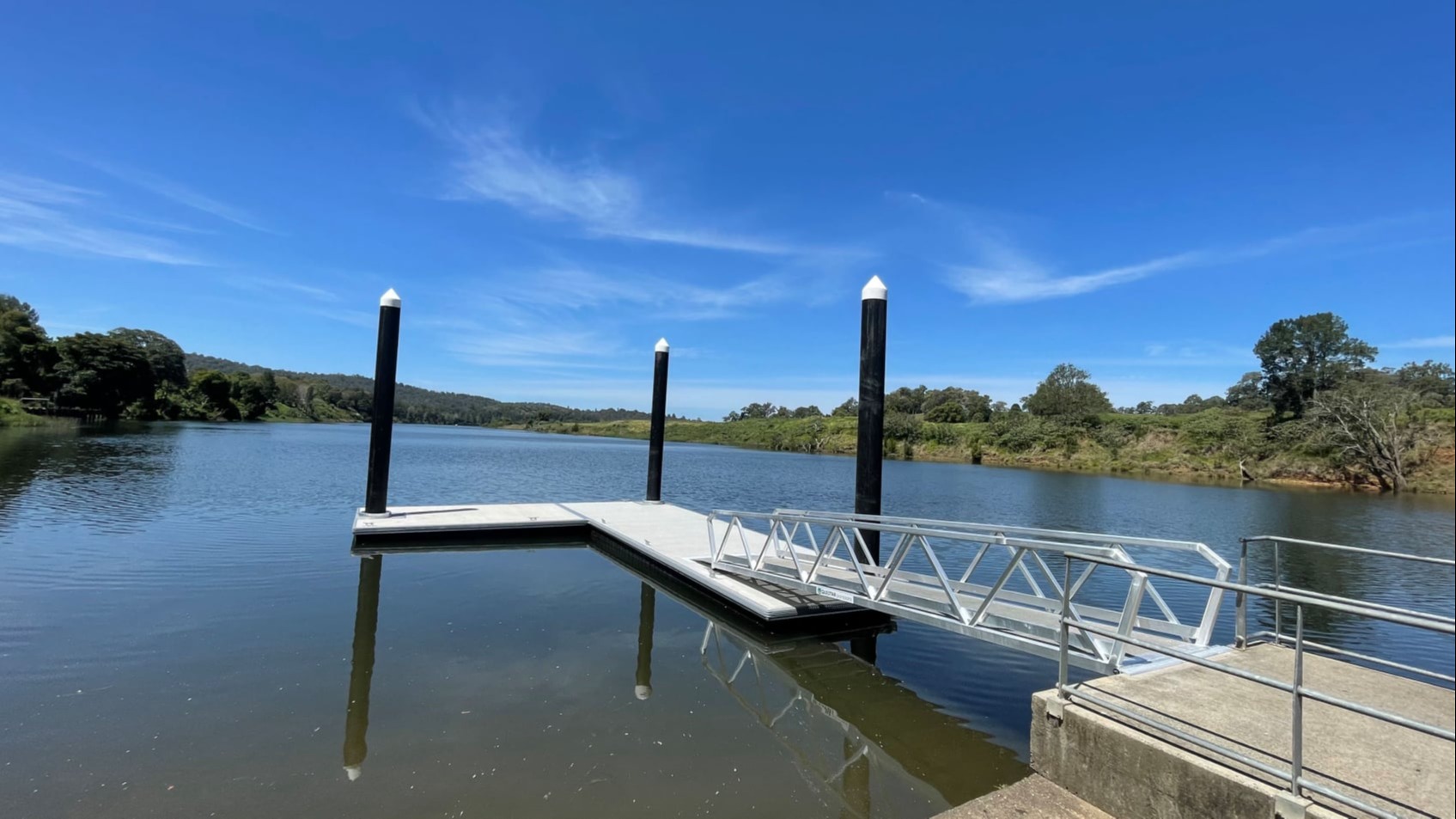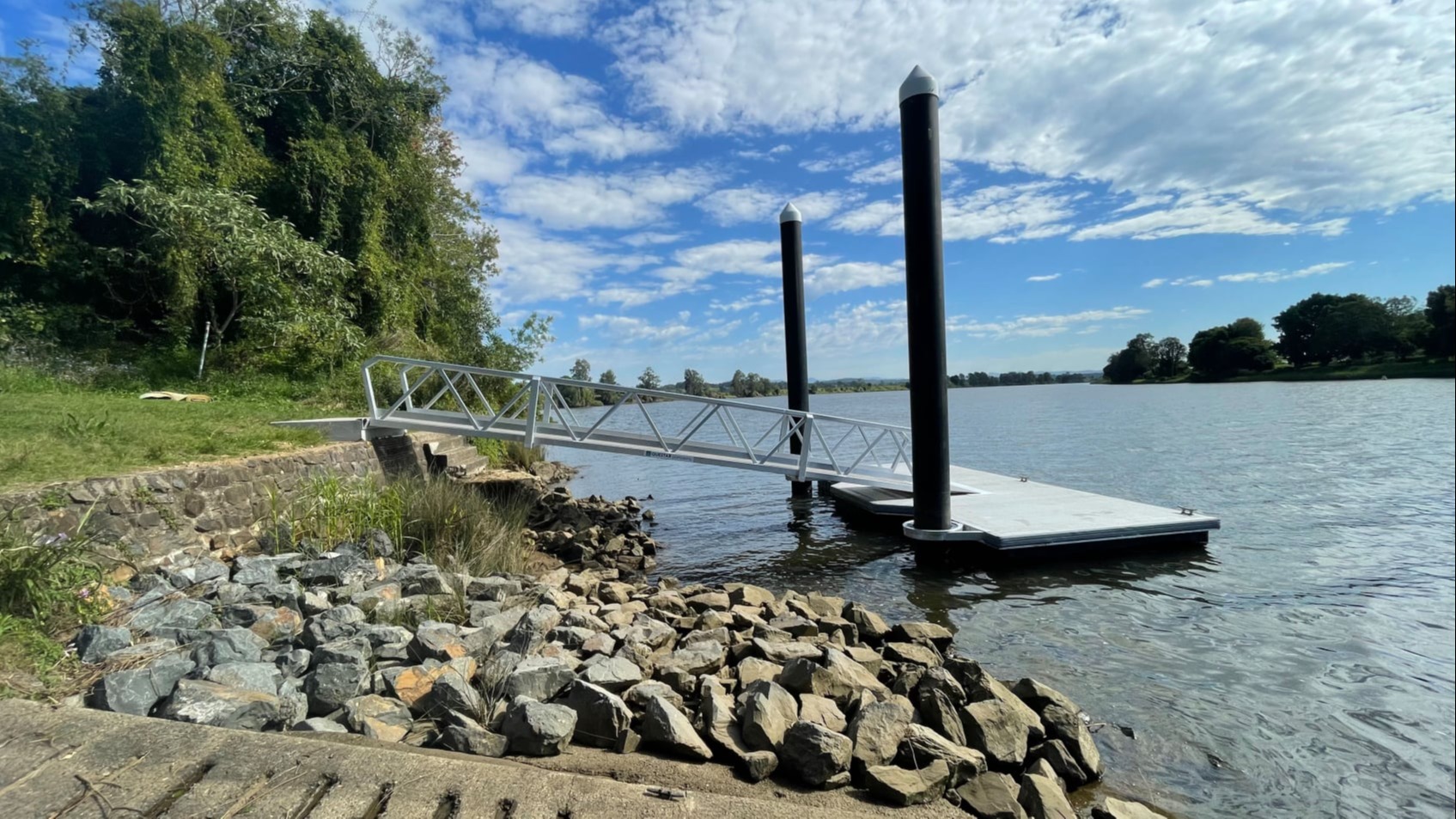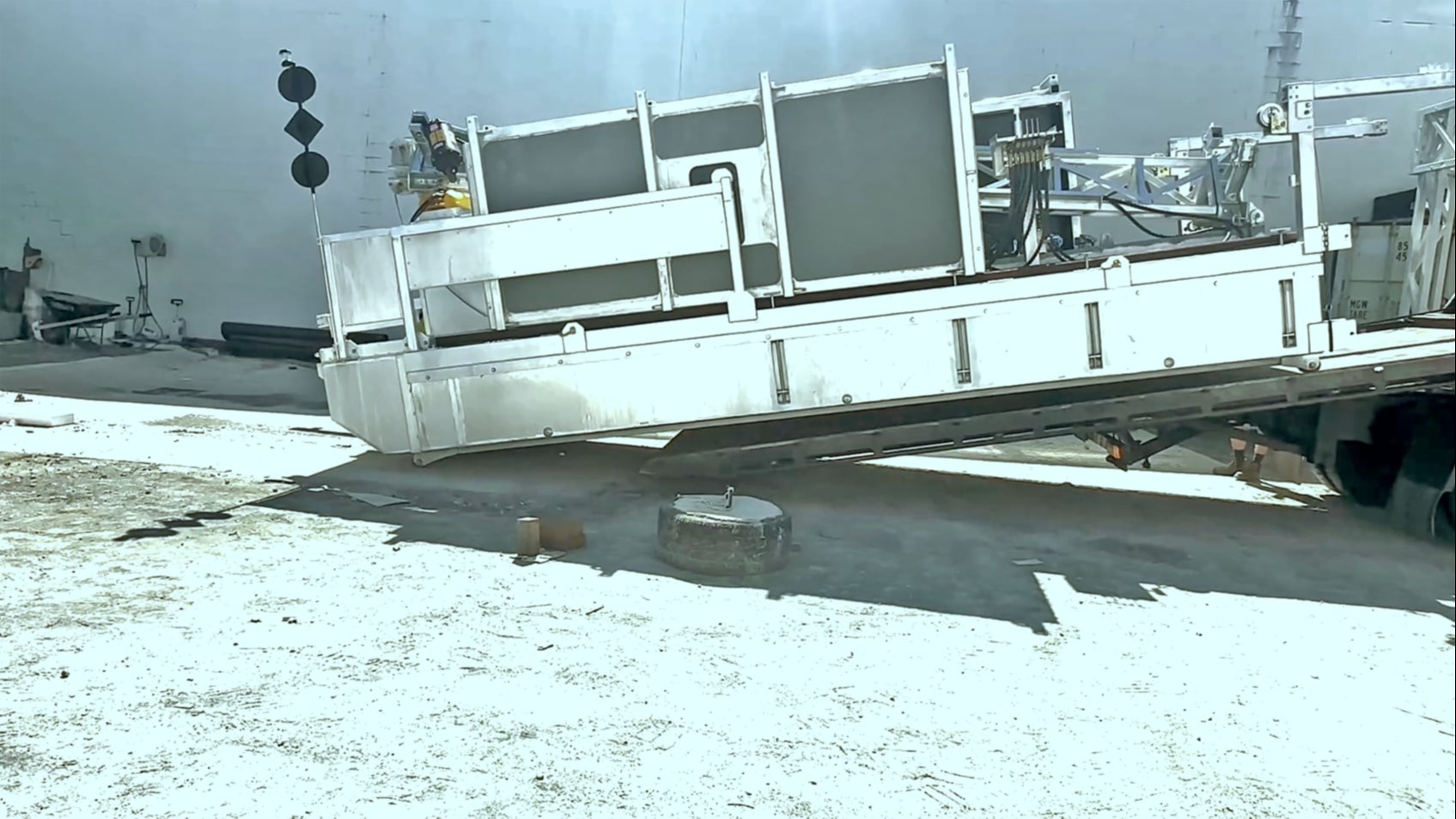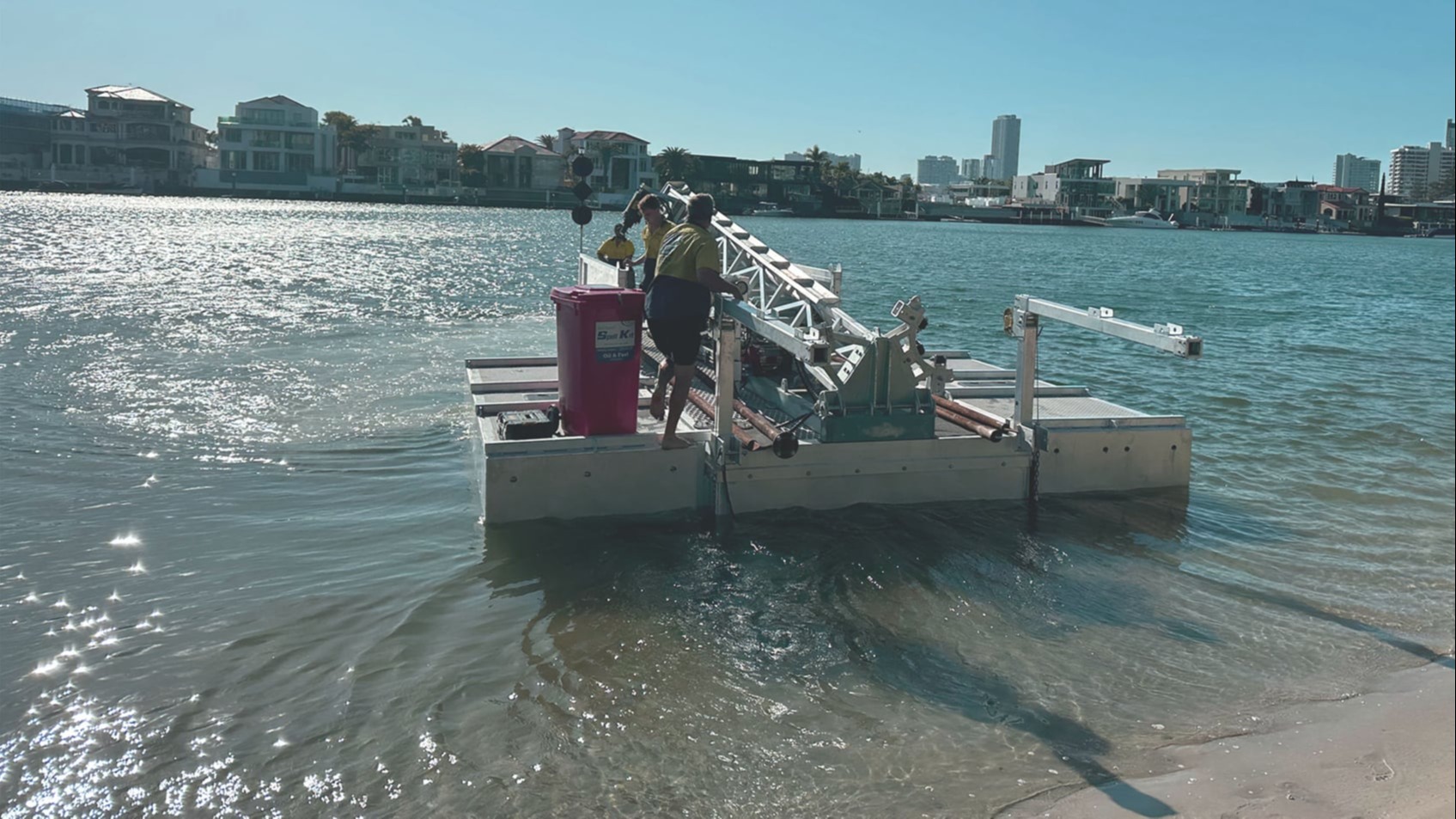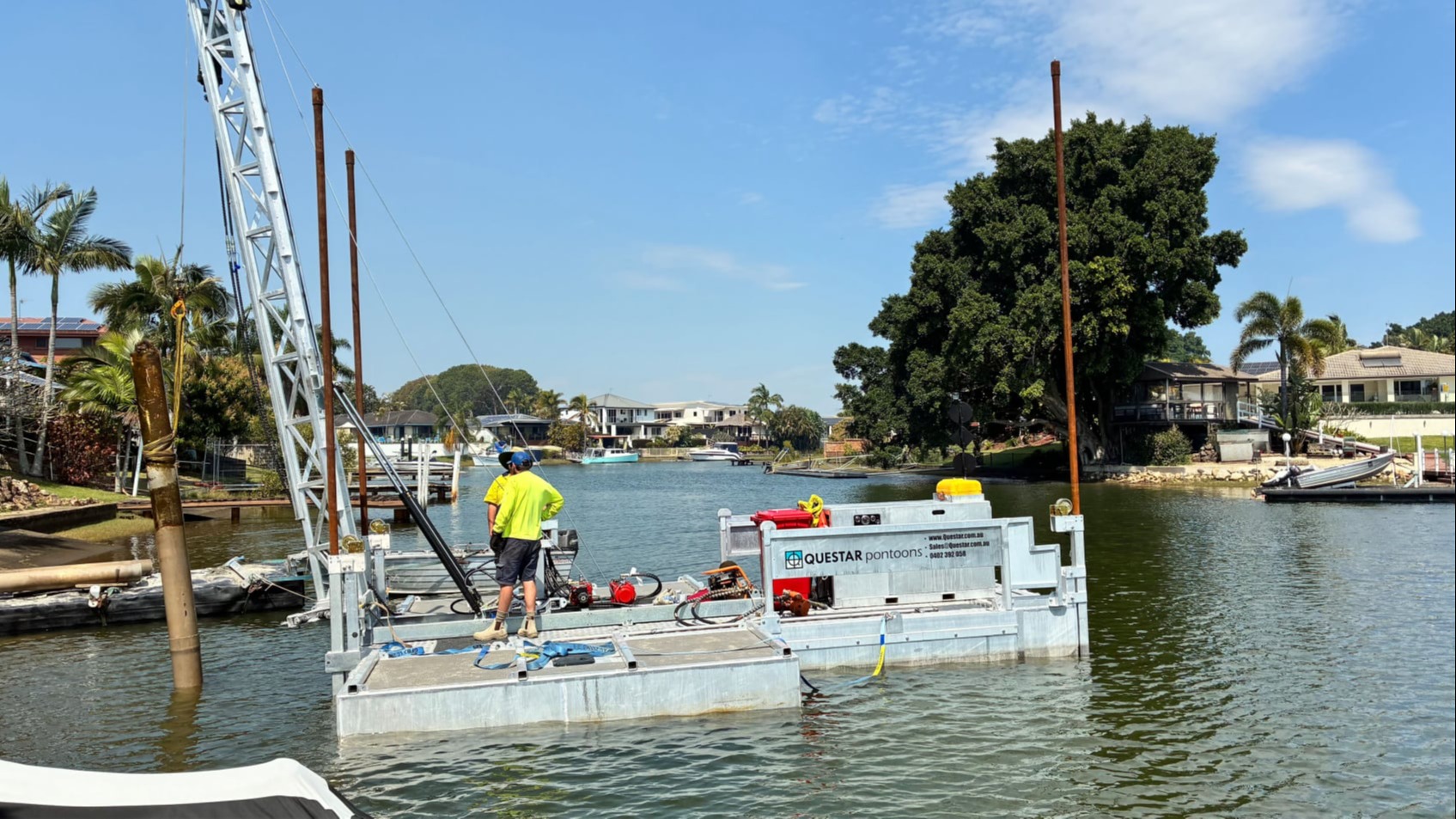Your Questions Answered
A piled pontoon is a type of floating dock secured by piles driven into the seabed, providing a stable platform for waterfront installations. Below are the main characteristics and practical benefits of opting for a piled pontoon for uses such as boating, recreation, or property enhancement:
1. Stability in Challenging Waters: Piled pontoons are anchored with piles made from materials like steel, concrete, or PVC, which offer horizontal stability and limit movement caused by tidal flows or wash zones. This design helps maintain secure mooring for vessels in areas exposed to strong currents or waves.
2. Adjustment to Tidal Variations: Unlike fixed jetties, piled pontoons move vertically with tidal changes due to pile brackets equipped with rollers. This feature maintains accessibility and usability during varying water levels and weather conditions.
3. Material Durability: These structures use marine-grade materials such as aluminum or concrete with steel reinforcement, increasing resistance to rot, marine borers, and environmental wear compared to timber jetties, leading to greater longevity when adequately maintained.
4. Maintenance Requirements: Piled pontoons generally require less frequent upkeep than timber jetties, except for routine inspections for barnacle growth and roller function. This results in lower long-term maintenance needs.
5. Flexible Applications: Piled pontoons accommodate multiple activities including mooring boats and jet skis, or serving as platforms for fishing, relaxation, or gatherings. They can be customized with features such as dry berthing for certain boat sizes, marine carpets, or utility conduits.
6. Impact on Property Value: Installing a piled pontoon can enhance the practicality and attractiveness of waterfront properties, potentially affecting property values and appeal to buyers interested in boating or recreational opportunities.
7. Location Suitability: These pontoons are appropriate for environments like the Gold Coast, where shallow waters and suitable soil allow for cost-effective installation methods, such as using in-situ PVC piles.
Aesthetic Considerations: Options such as HDPE sleeves for steel piles and various pile caps are available, enabling integration of functional and contemporary design elements into waterfront settings.
A strut pontoon is a floating dock system anchored by rigid struts, typically connected to a fixed jetty or shore-based structure, designed to deliver a stable and cost-efficient solution for waterfront properties. The following outlines the principal advantages of investing in a strut pontoon, making it an optimal choice for boating enthusiasts, owners of waterfront homes, or those requiring practical docking solutions:
1. Cost-Effective Installation: Strut pontoons generally involve lower installation costs than piled pontoons, as they eliminate the need for expensive pile-driving into the seabed. The struts, frequently constructed from durable materials such as stainless steel or aluminum, facilitate simpler installation processes, thereby reducing both labour and material expenses.
2. Stability in Calm Waters: The rigid strut system firmly secures the pontoon to a fixed structure, ensuring exceptional stability within protected waterways such as canals and sheltered harbours. This provides safe and reliable mooring for boats, jet skis, and recreational activities.
3. Adaptability to Water Levels: As floating structures, strut pontoons adjust vertically with tidal variations or water level changes, offering consistent accessibility. The design allows smooth vertical movement, maintaining the operational functionality of the pontoon under varying environmental conditions.
4. Low Maintenance Requirements: Manufactured from marine-grade materials like aluminium or polyethylene, strut pontoons exhibit high resistance to corrosion, rot, and marine growth. Routine maintenance, such as periodic cleaning and inspections, suffices to preserve their condition and extend service life, thereby minimising ongoing costs.
5. Versatility for Small to Medium Vessels: Particularly suitable for private waterfront properties, strut pontoons are capable of supporting vessels up to approximately 6–8 metres in length, depending on specific design parameters. They may be customised with enhancements such as cleats, fenders, or marine carpet to increase utility and comfort.
6. Ease of Installation and Relocation: The simplified anchoring system enables straightforward installation or relocation compared to piled systems, providing flexibility for property owners who may wish to modify or upgrade their docking arrangements over time.
7. Enhanced Property Appeal: Incorporating a strut pontoon enhances both the functional and aesthetic value of waterfront properties, representing a compelling feature for prospective buyers in boating-oriented regions such as the Gold Coast.
Suitability for Shallow or Stable Waters: Strut pontoons are particularly effective in shallow canals or low-wash environments, where tidal movement is minimal. Their design aligns well with canal systems or similarly stable settings characterised by steady soil and water conditions.
Although strut pontoons may not provide the same degree of durability as piled pontoons in high-wash or exposed locations, their affordability, ease of installation, and reliability in calmer waters make them a highly advantageous option for many waterfront property owners.
A cable pontoon is a type of floating dock system anchored by cables—typically stainless steel or marine-grade ropes—secured to the seabed or shoreline. This configuration provides a flexible and cost-efficient docking solution for waterfront properties. The following outlines the principal advantages of investing in a cable pontoon, making it particularly attractive for homeowners, boating enthusiasts, and those seeking affordable and versatile pontoon options.
1.cEase of Installation: The installation process for cable-anchored pontoons is uncomplicated, typically requiring only seabed anchors or shore-based fixtures. As a result, labor costs are reduced, and setup can be completed more rapidly compared to pile-driven alternatives.
2. Flexibility in Water Conditions: The cable anchoring method allows pontoons to adapt to tidal changes or fluctuations in water level, maintaining accessibility in environments with calm to moderate tides. This flexibility is well-suited to canals or sheltered waterways.
3. Low Maintenance: Constructed from robust materials such as aluminum, polyethylene, or composite decking, cable pontoons offer high resistance to corrosion, rot, and marine growth. Routine maintenance primarily involves periodic checks of cable tension and standard cleaning, keeping overall upkeep costs minimal.
4. Suitability for Shallow Waters: Cable pontoons are highly suitable for shallow canals or areas with soft seabeds, as they do not require deep pile driving. This makes them ideal choices for regions such as the Gold Coast’s canal networks.
5. Portability and Adjustability: The cable system enables straightforward relocation or reconfiguration compared to fixed or piled pontoons. Homeowners may conveniently adjust or move the pontoon as needs evolve.
6. Versatile Applications: Cable pontoons accommodate small to medium vessels, jet skis, and serve as platforms for recreational activities including fishing, swimming, or entertaining. They can also be tailored with accessories like ladders, fenders, or lighting to enhance their utility.
7. Property Value Enhancement: Installing a cable pontoon increases the appeal of waterfront properties by providing functional docking space, thereby attracting boating enthusiasts and potentially increasing resale value within water-oriented communities.
While cable pontoons may not provide the same degree of stability as piled or strut systems in areas subject to significant wash or exposure, their affordability, ease of installation, and suitability for calm, shallow waters make them an excellent solution for many property owners.
A pontoon constructed from lightweight materials such as aluminum and polystyrene blocks encased in an HDPE (high-density polyethylene) liner, with fully welded construction, provides several features relevant to waterfront homeowners, boaters, or recreational users. The following list outlines the characteristics of this type of pontoon, particularly for shallow canal areas or similar settings:
1. Maneuverability in Shallow Waters: The combination of a lightweight aluminum frame and polystyrene core reduces the pontoon’s draft, enabling it to float higher and move through shallow canals or waterways efficiently, reducing the likelihood of grounding.
2. Corrosion Resistance: Aluminum exhibits natural resistance to corrosion in marine environments, while the HDPE liner shields polystyrene blocks from water penetration and deterioration, promoting durability against saltwater, UV exposure, and marine organisms.
3. Low Maintenance: The fully welded aluminum structure minimizes loose joints or fasteners that might corrode or loosen, and the HDPE liner resists the accumulation of marine growth. This design generally requires limited maintenance.
4. Lightweight and Strong: Aluminum offers a high strength-to-weight ratio, and the polystyrene blocks contribute buoyancy without significant weight, resulting in a platform capable of supporting boats or recreation while remaining manageable.
5. Installation and Relocation: Due to its light weight, this pontoon is easier to transport, install, and reposition than heavier alternatives, which can reduce associated labor efforts and support various waterfront applications.
6. Environmental Considerations and Durability: Polystyrene covered by HDPE is non-toxic and resistant to degradation, which may lessen environmental impact. The fully welded build is intended to enhance service life in marine conditions.
7. Customization Options: These pontoons can be outfitted with features such as marine carpet, cleats, or conduits for utilities, accommodating small boats, jet skis, or platforms in calm waters like those found in Gold Coast canals.
8. Cost Efficiency: The use of lightweight materials can lower manufacturing and installation expenses compared to heavier designs, offering a cost-effective solution for protected, shallow environments.
Although these pontoons may not be ideal for high-wash or exposed waters in comparison to piled pontoons, a lightweight aluminum and polystyrene pontoon with an HDPE liner is suitable for use in shallow, calm waterways, emphasizing durability and ease of use.
A pontoon constructed from lightweight materials such as aluminum and polystyrene blocks encased in an HDPE (high-density polyethylene) liner, with fully welded construction, provides several features relevant to waterfront homeowners, boaters, or recreational users. The following list outlines the characteristics of this type of pontoon, particularly for shallow canal areas or similar settings:
1. Maneuverability in Shallow Waters: The combination of a lightweight aluminum frame and polystyrene core reduces the pontoon’s draft, enabling it to float higher and move through shallow canals or waterways efficiently, reducing the likelihood of grounding.
2. Corrosion Resistance: Aluminum exhibits natural resistance to corrosion in marine environments, while the HDPE liner shields polystyrene blocks from water penetration and deterioration, promoting durability against saltwater, UV exposure, and marine organisms.
3. Low Maintenance: The fully welded aluminum structure minimizes loose joints or fasteners that might corrode or loosen, and the HDPE liner resists the accumulation of marine growth. This design generally requires limited maintenance.
4. Lightweight and Strong: Aluminum offers a high strength-to-weight ratio, and the polystyrene blocks contribute buoyancy without significant weight, resulting in a platform capable of supporting boats or recreation while remaining manageable.
5. Installation and Relocation: Due to its light weight, this pontoon is easier to transport, install, and reposition than heavier alternatives, which can reduce associated labor efforts and support various waterfront applications.
6. Environmental Considerations and Durability: Polystyrene covered by HDPE is non-toxic and resistant to degradation, which may lessen environmental impact. The fully welded build is intended to enhance service life in marine conditions.
7. Customization Options: These pontoons can be outfitted with features such as marine carpet, cleats, or conduits for utilities, accommodating small boats, jet skis, or platforms in calm waters like those found in Gold Coast canals.
8. Cost Efficiency: The use of lightweight materials can lower manufacturing and installation expenses compared to heavier designs, offering a cost-effective solution for protected, shallow environments.
Although these pontoons may not be ideal for high-wash or exposed waters in comparison to piled pontoons, a lightweight aluminum and polystyrene pontoon with an HDPE liner is suitable for use in shallow, calm waterways, emphasizing durability and ease of use.
A timber jetty is a fixed or floating dock structure primarily constructed from treated timber, designed for waterfront properties, marinas, or recreational use. Here are the key advantages of purchasing a timber jetty, ideal for homeowners, boaters, or those seeking an aesthetic and functional waterfront solution:
1. Aesthetic Appeal: Timber jetties offer a natural, warm aesthetic that blends seamlessly with coastal or riverfront environments, enhancing the visual charm of properties compared to metal or concrete alternatives.
2. Cost-Effective Option: Timber is often more affordable than materials like aluminum or concrete for initial construction, making it a budget-friendly choice for private docks or small marinas.
3. Versatility for Various Uses: Timber jetties support mooring boats, jet skis, or recreational activities like fishing, swimming, or entertaining, with customizable features like decking, railings, or ladders.
4. Eco-Friendly Material: When sourced sustainably and treated with environmentally safe sealants, timber jetties have a lower environmental impact than synthetic materials, appealing to eco-conscious buyers.
5. Easy Customization: Timber can be easily cut, shaped, or stained to match specific design preferences, allowing for tailored sizes, styles, or finishes to suit individual property needs.
6. Stable in Calm Waters: Fixed timber jetties provide a solid platform in shallow, low-wash areas like canals, offering reliable access for boats or recreational use without floating adjustments.
7. Property Value Enhancement: A well-designed timber jetty adds functional and aesthetic value to waterfront properties, making them more attractive to buyers in boating-focused regions like the Gold Coast.
8. Repairable and Replaceable: Timber components are relatively easy to repair or replace if damaged, allowing for cost-effective maintenance compared to fully welded metal structures.
While timber jetties may require regular maintenance (e.g., sealing or treating to prevent rot, fungi, or marine borer damage) and are less durable in high-wash or exposed waters compared to piled pontoons, their affordability, aesthetic appeal, and versatility make them an excellent choice for calm, sheltered environments.
